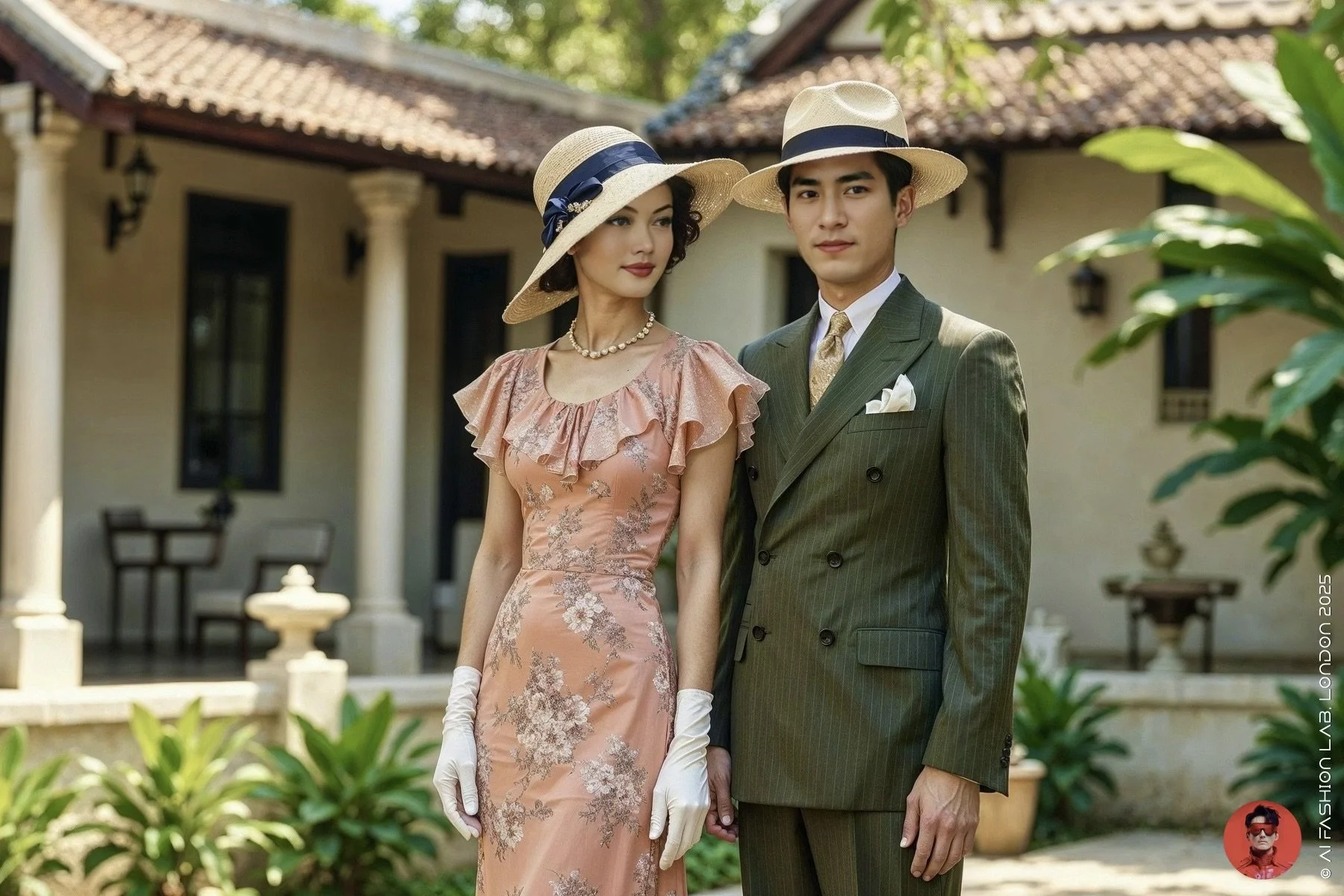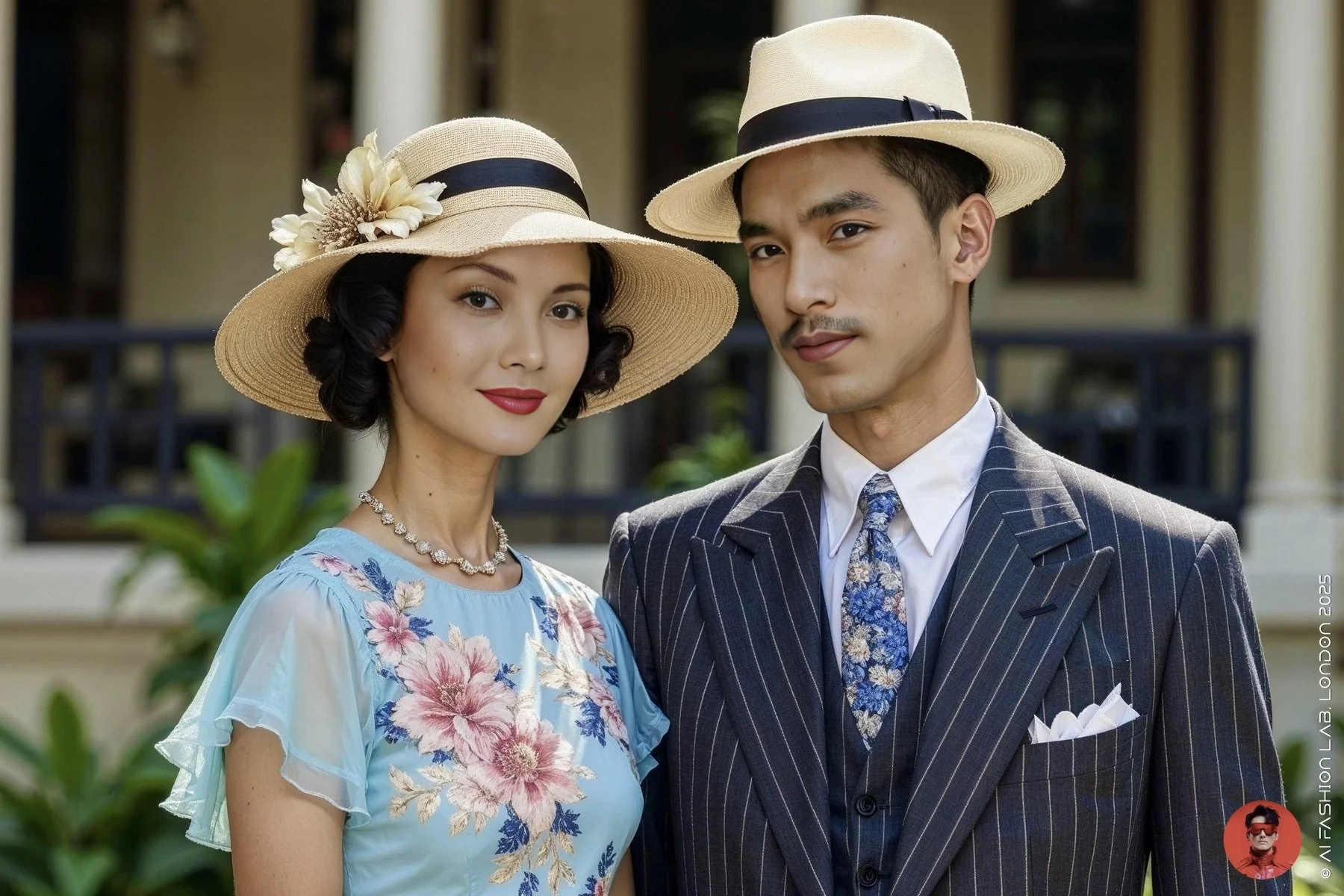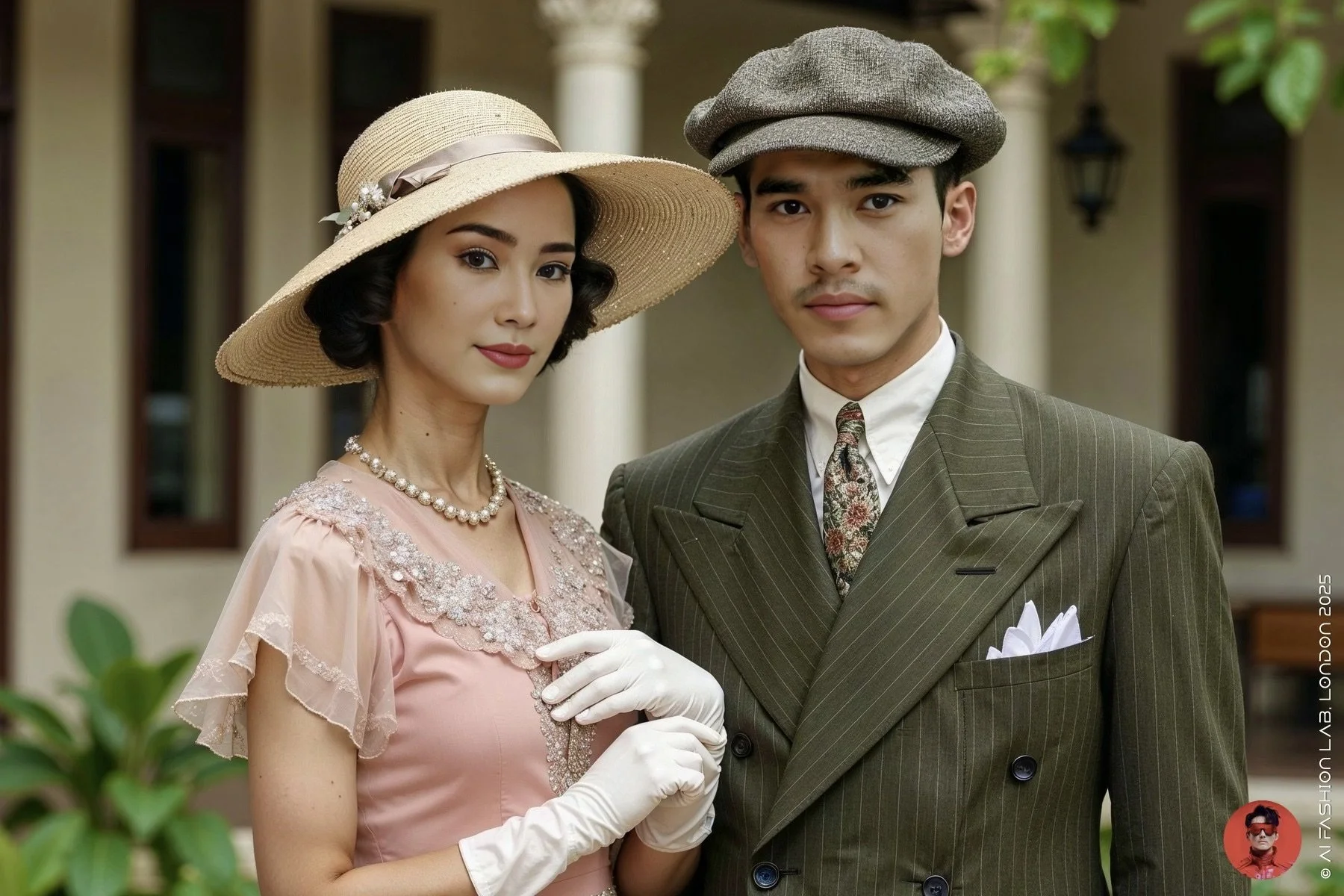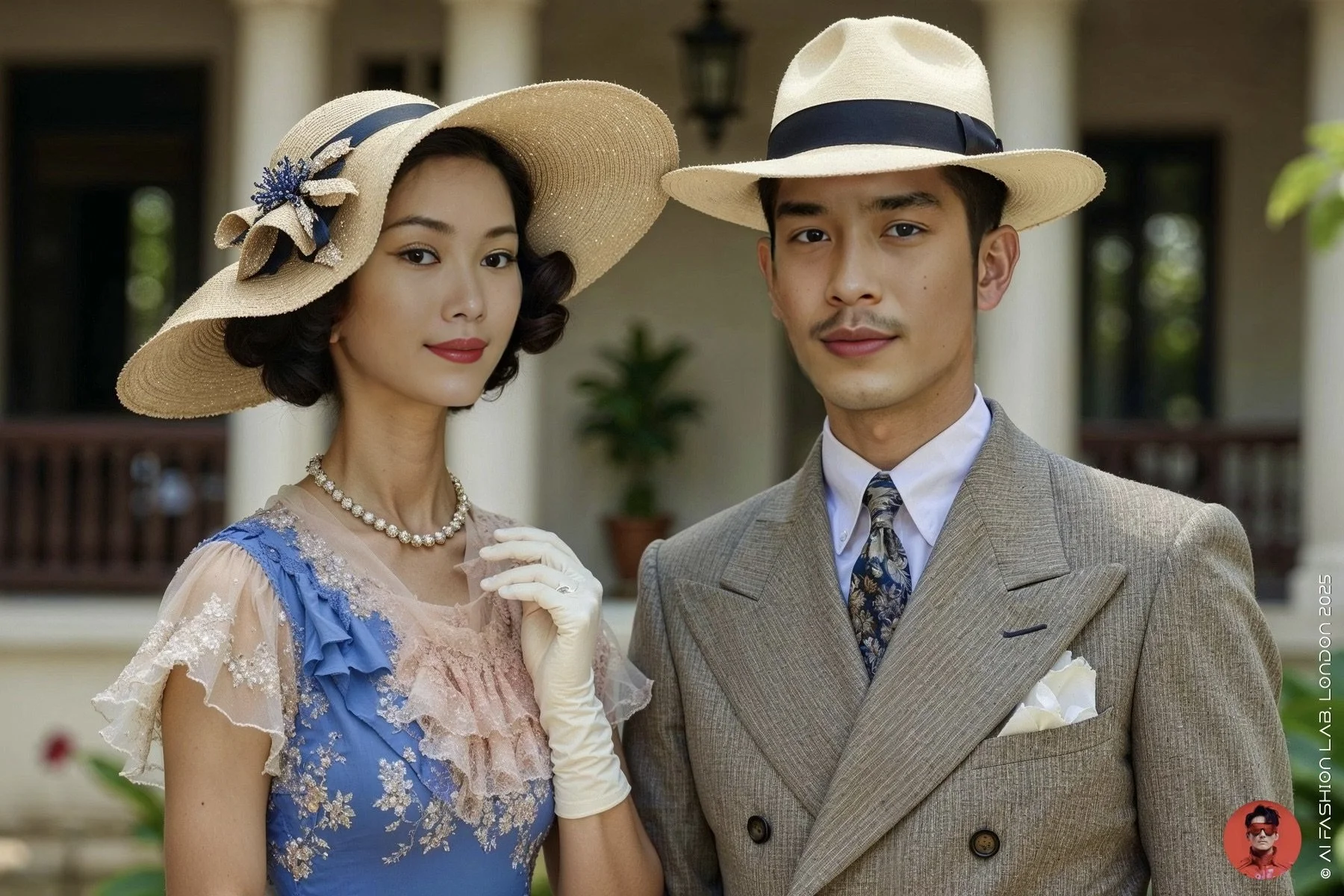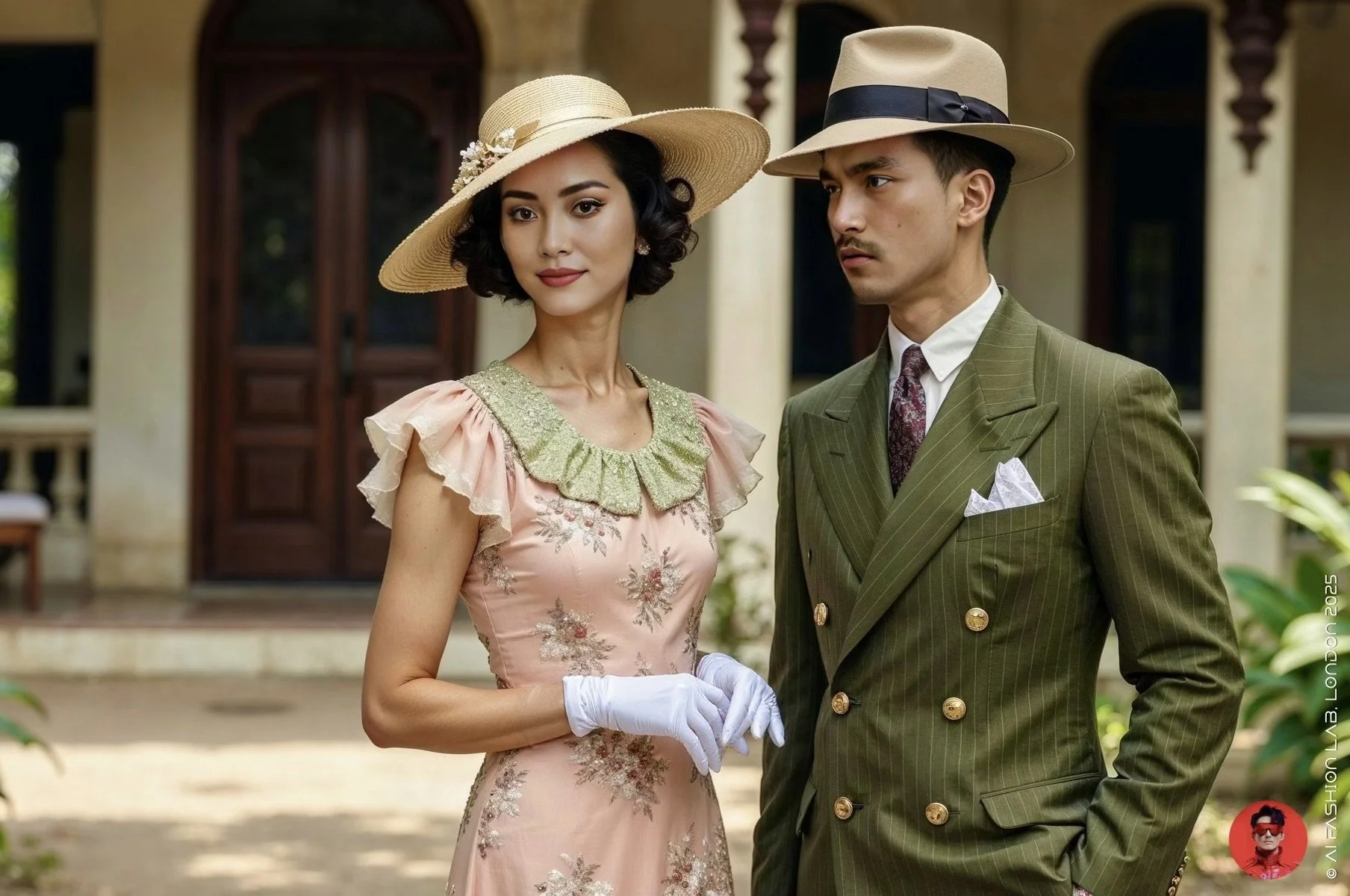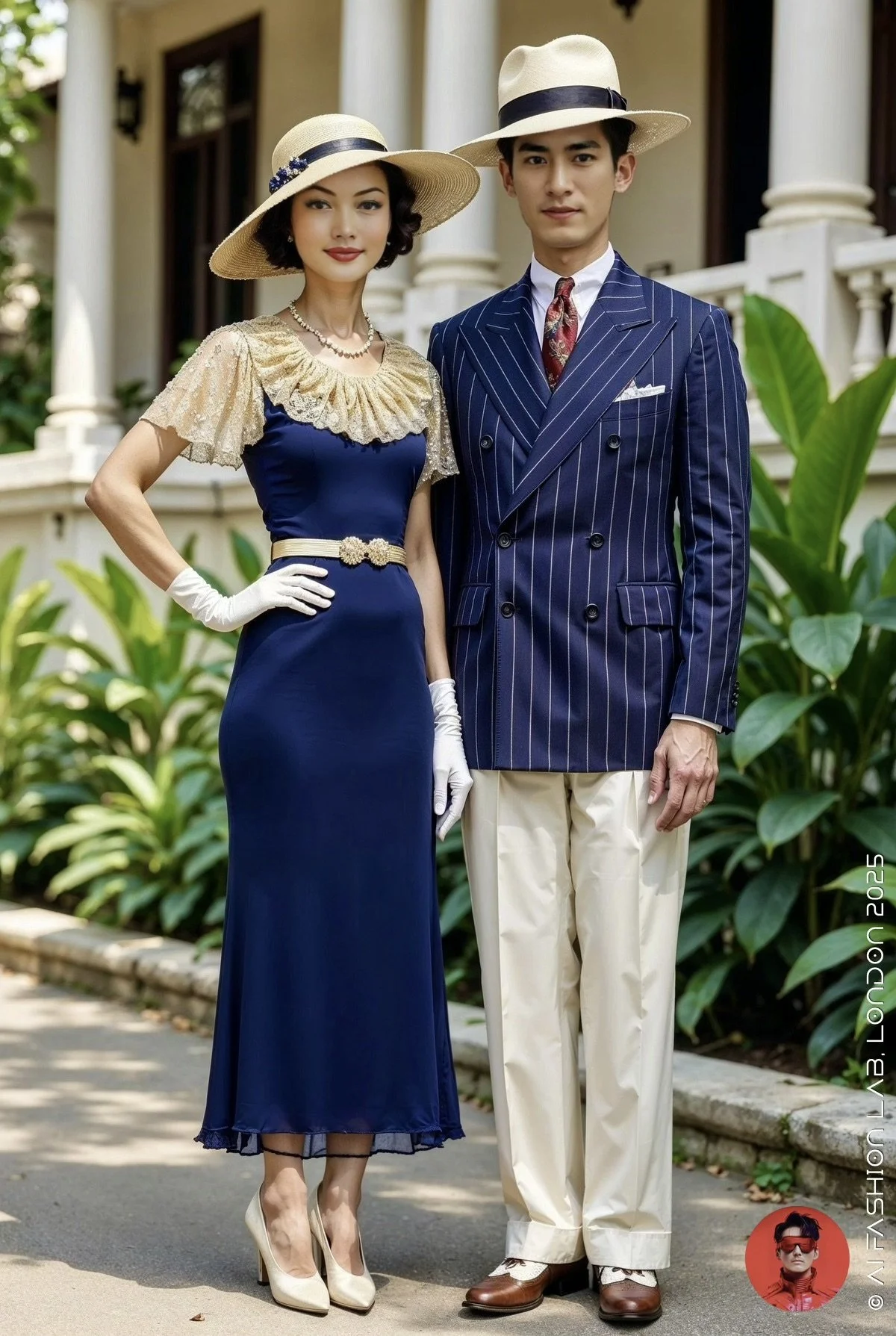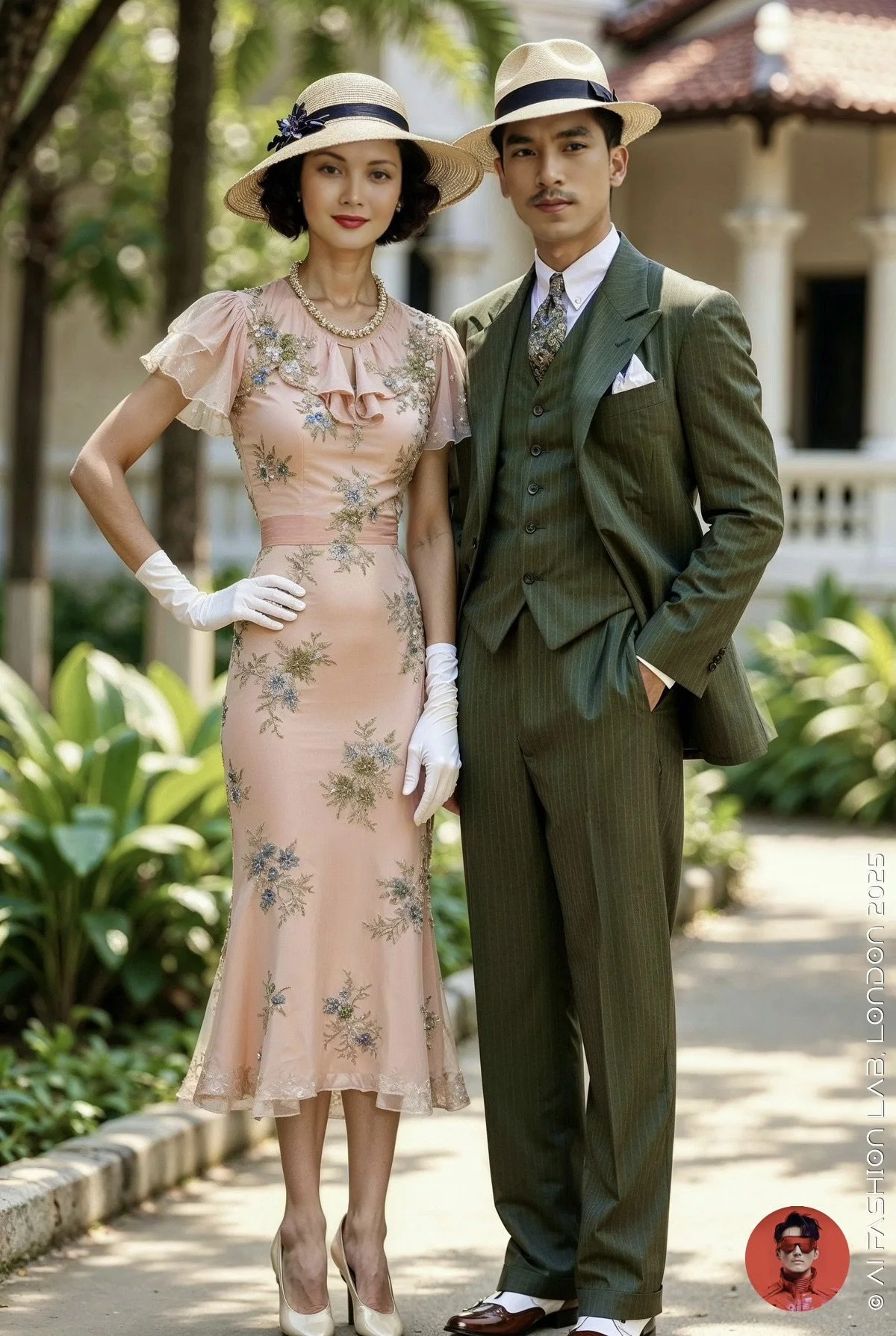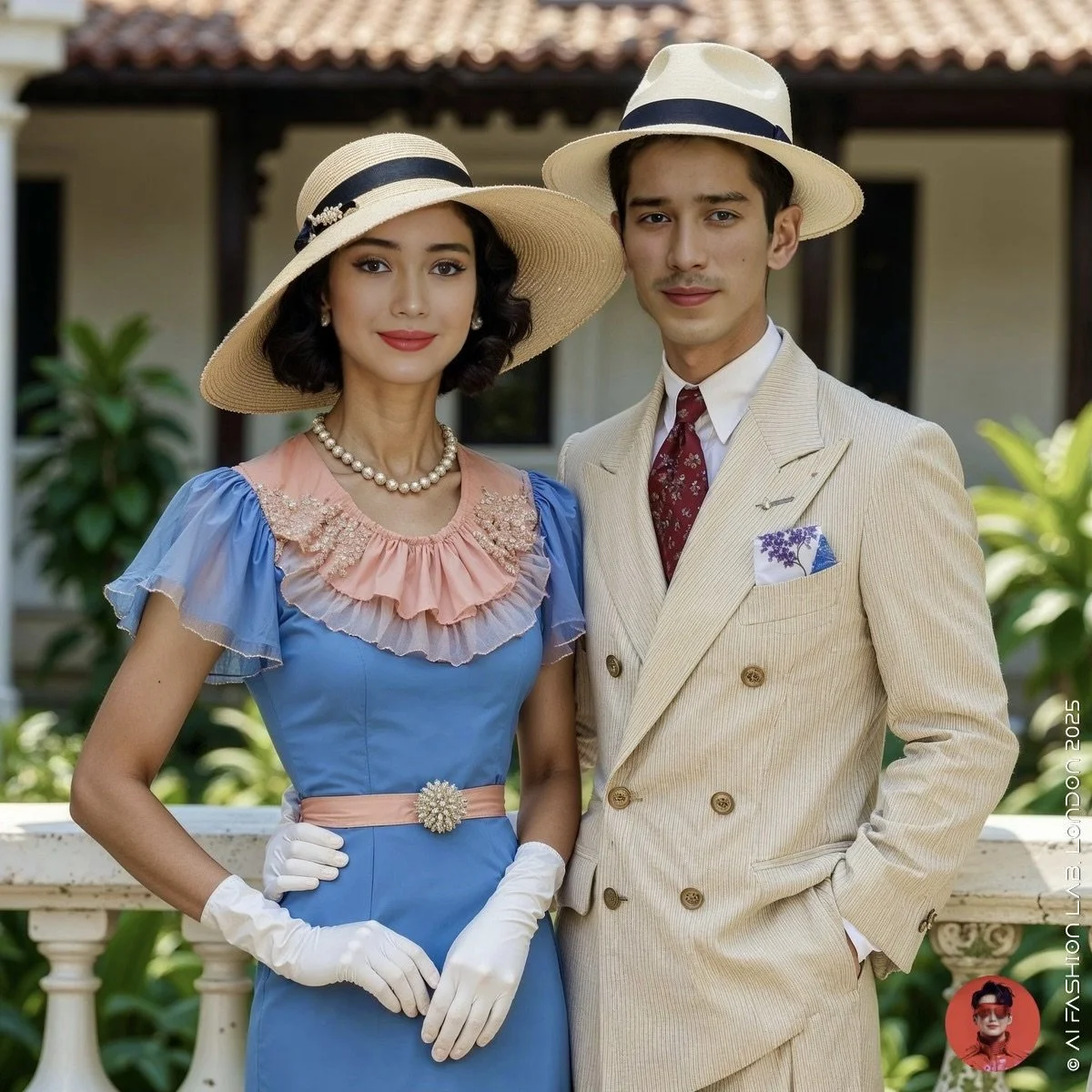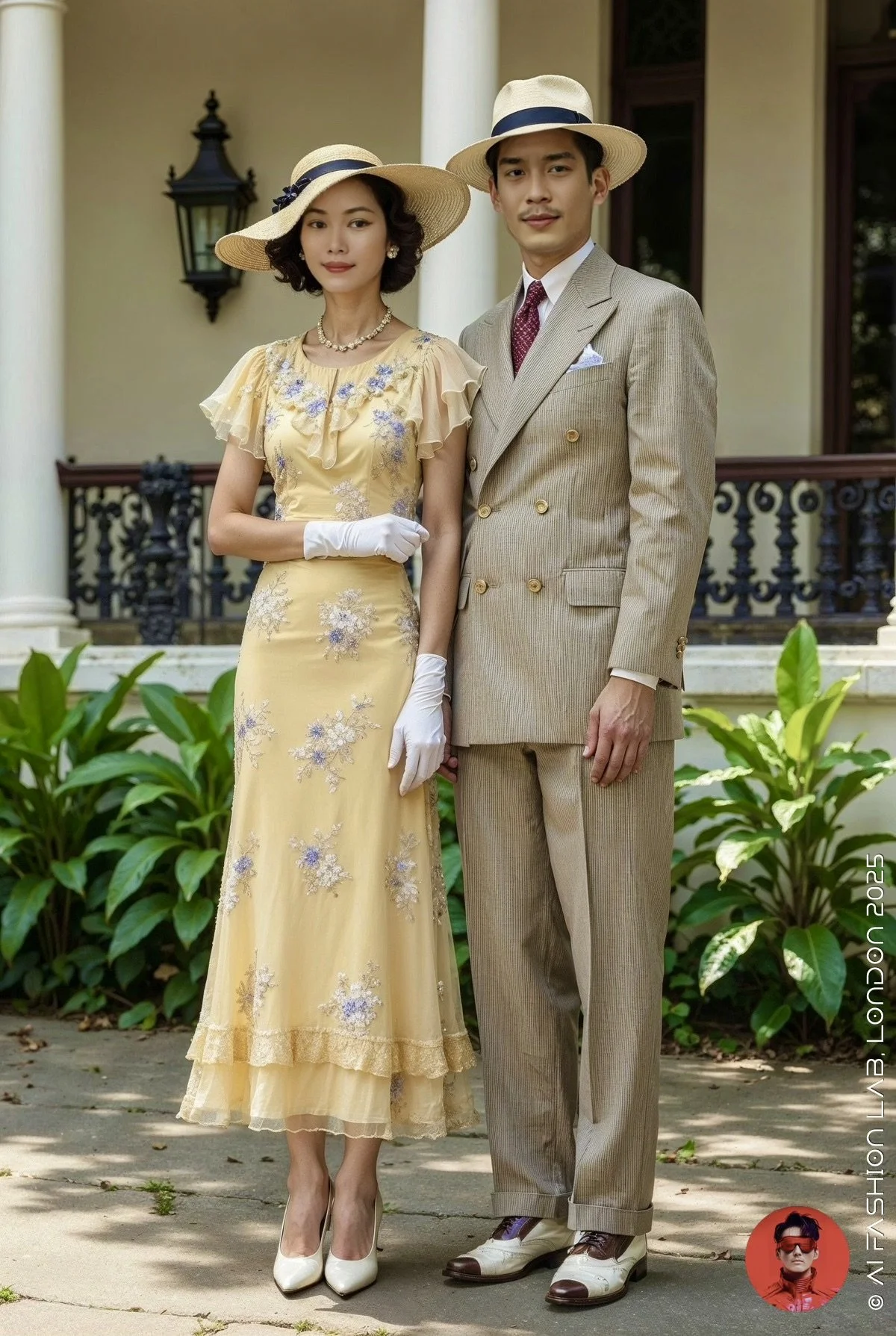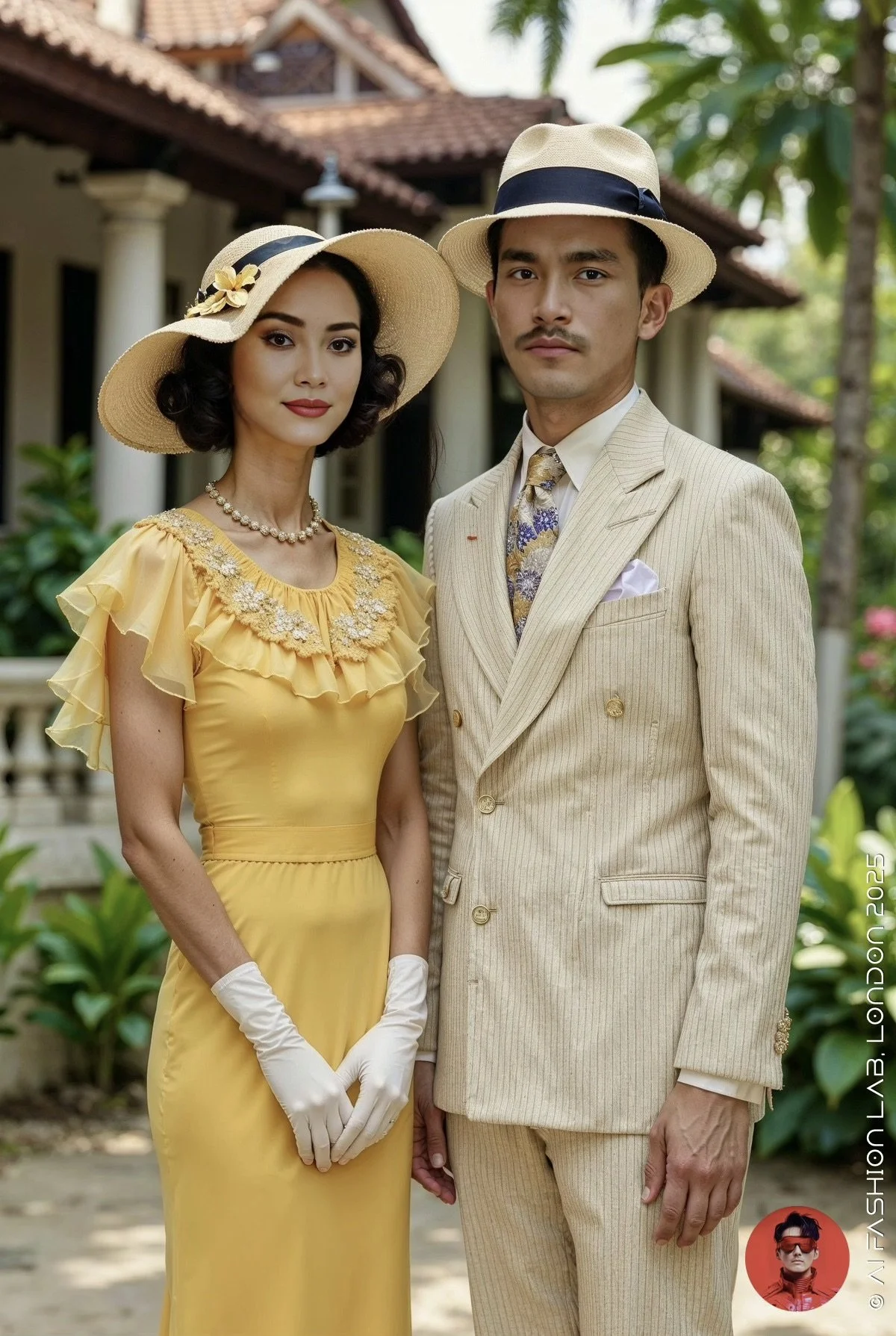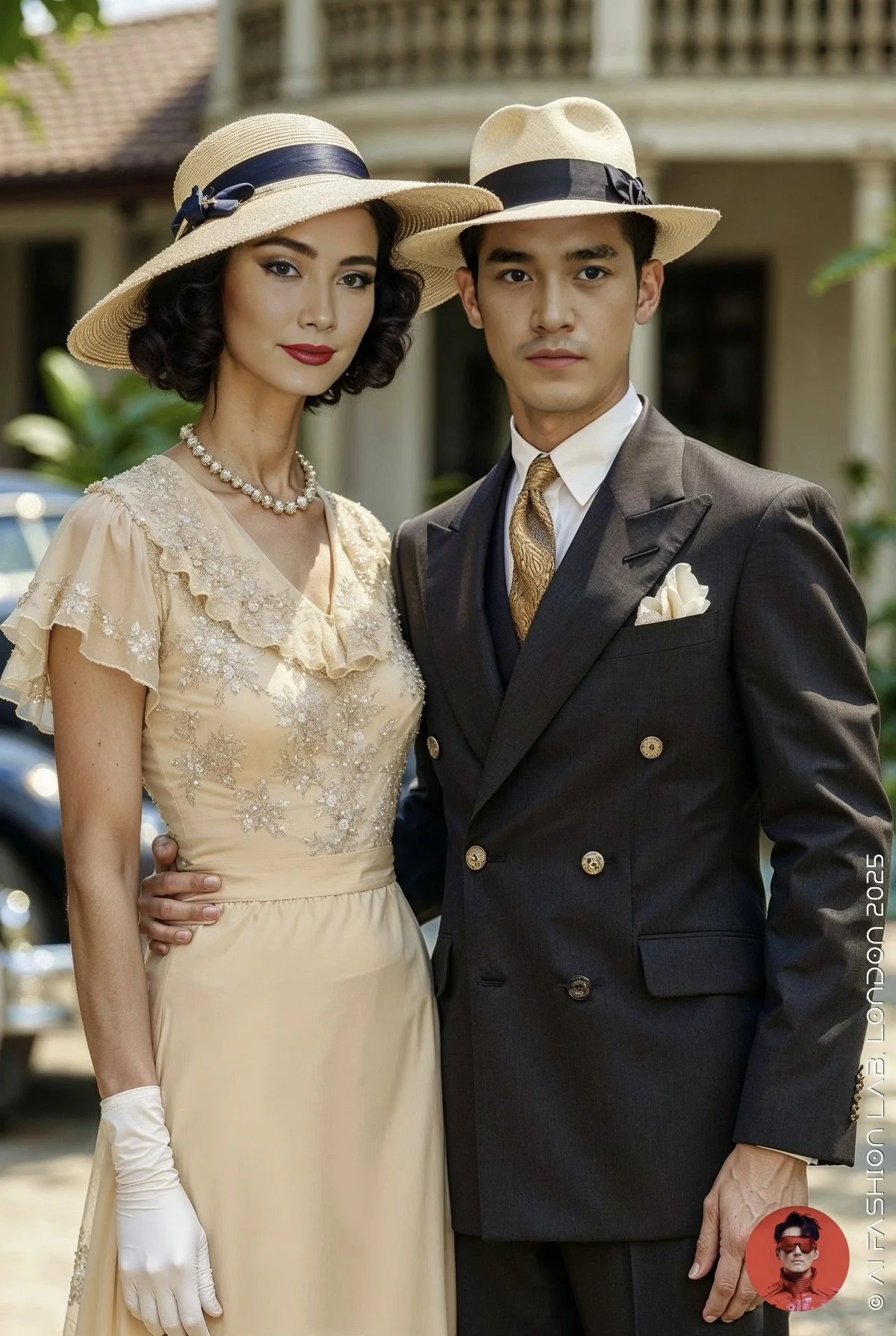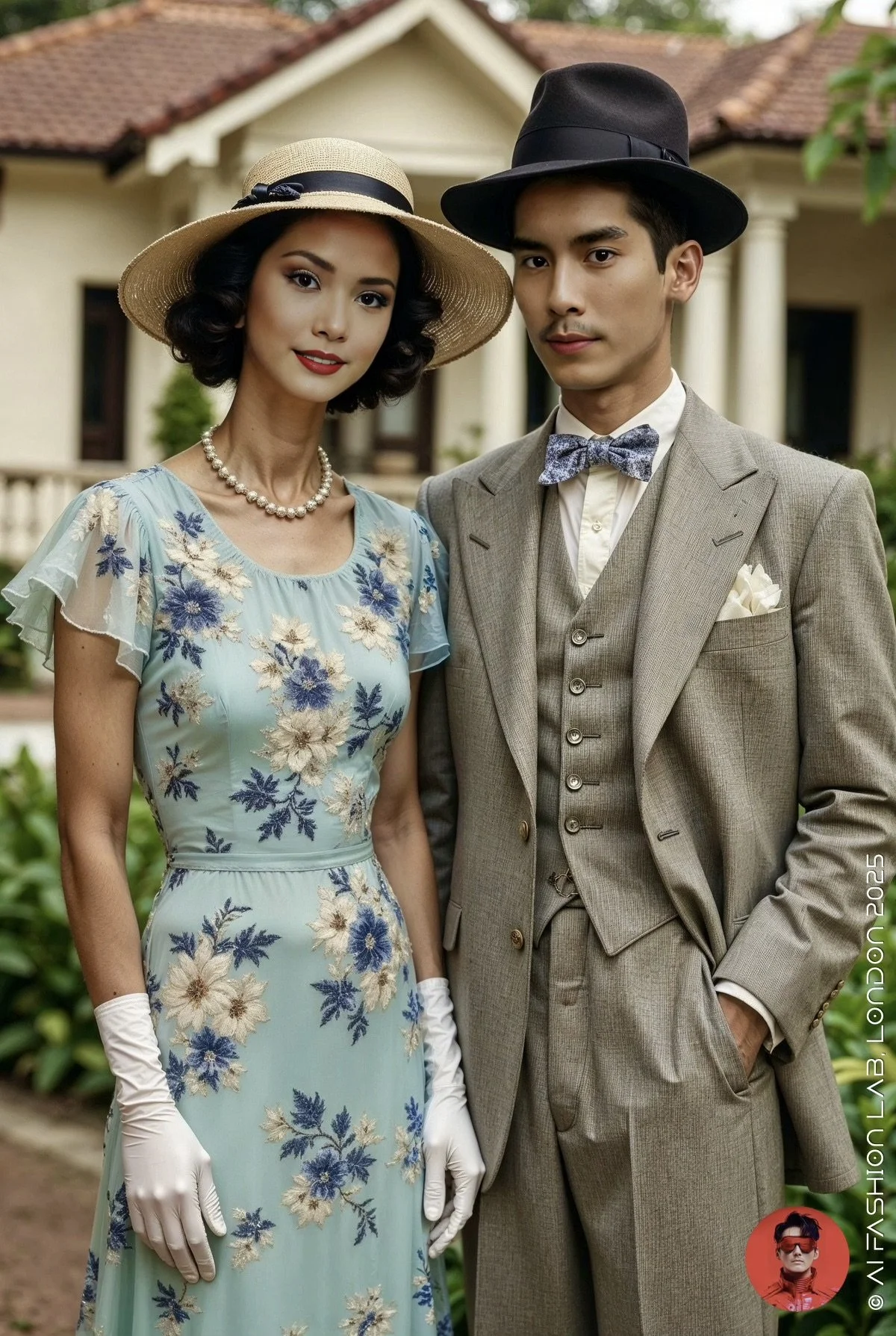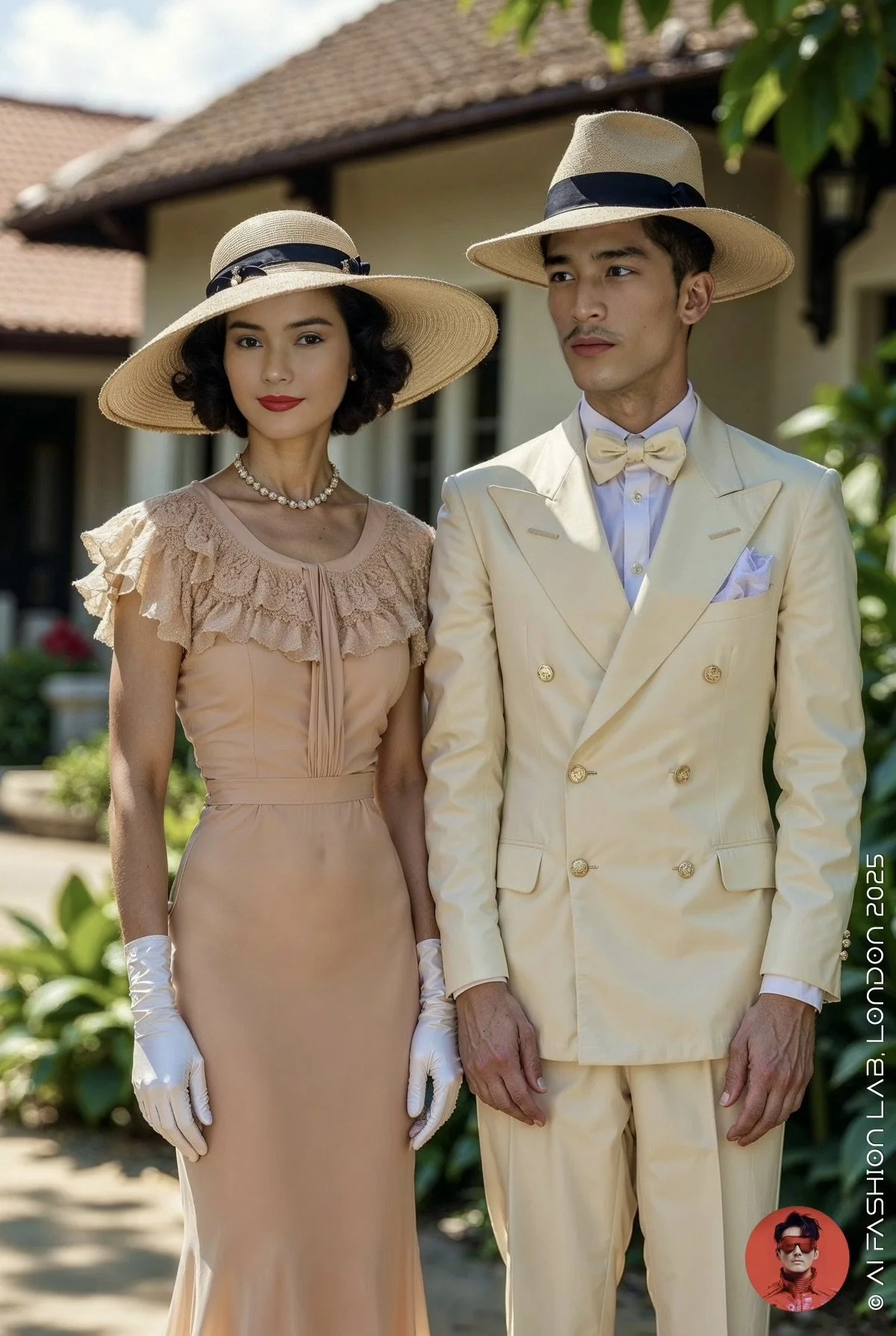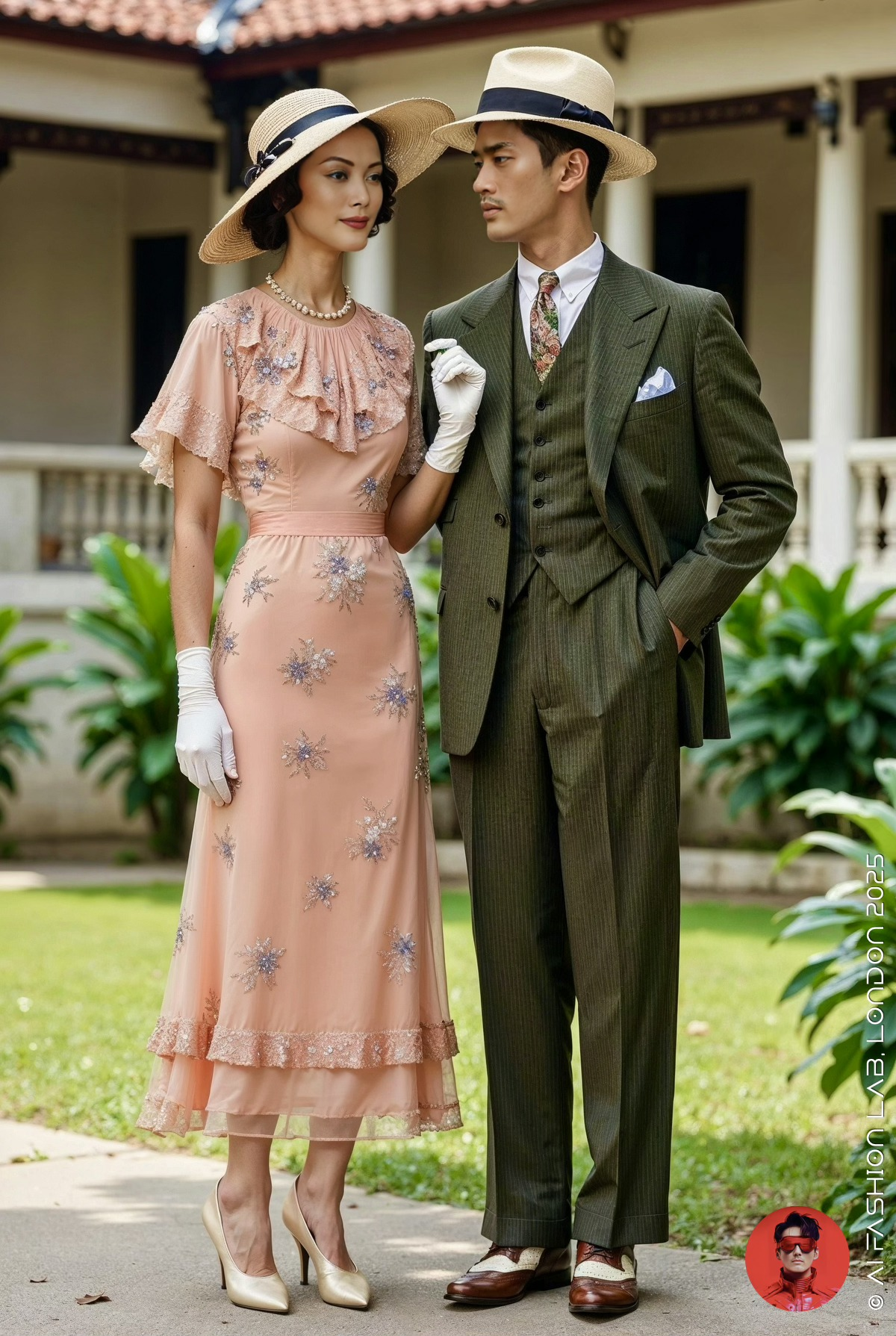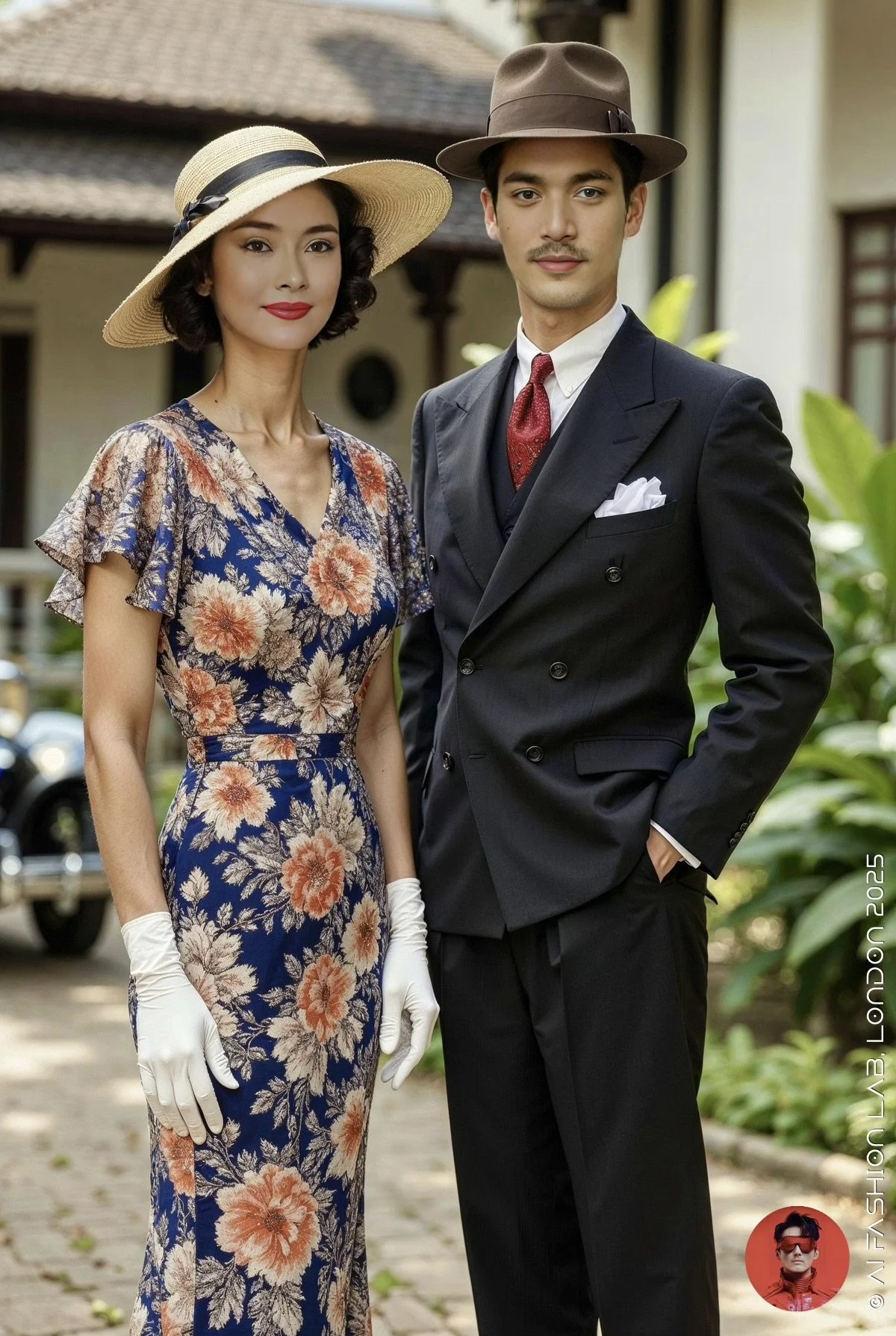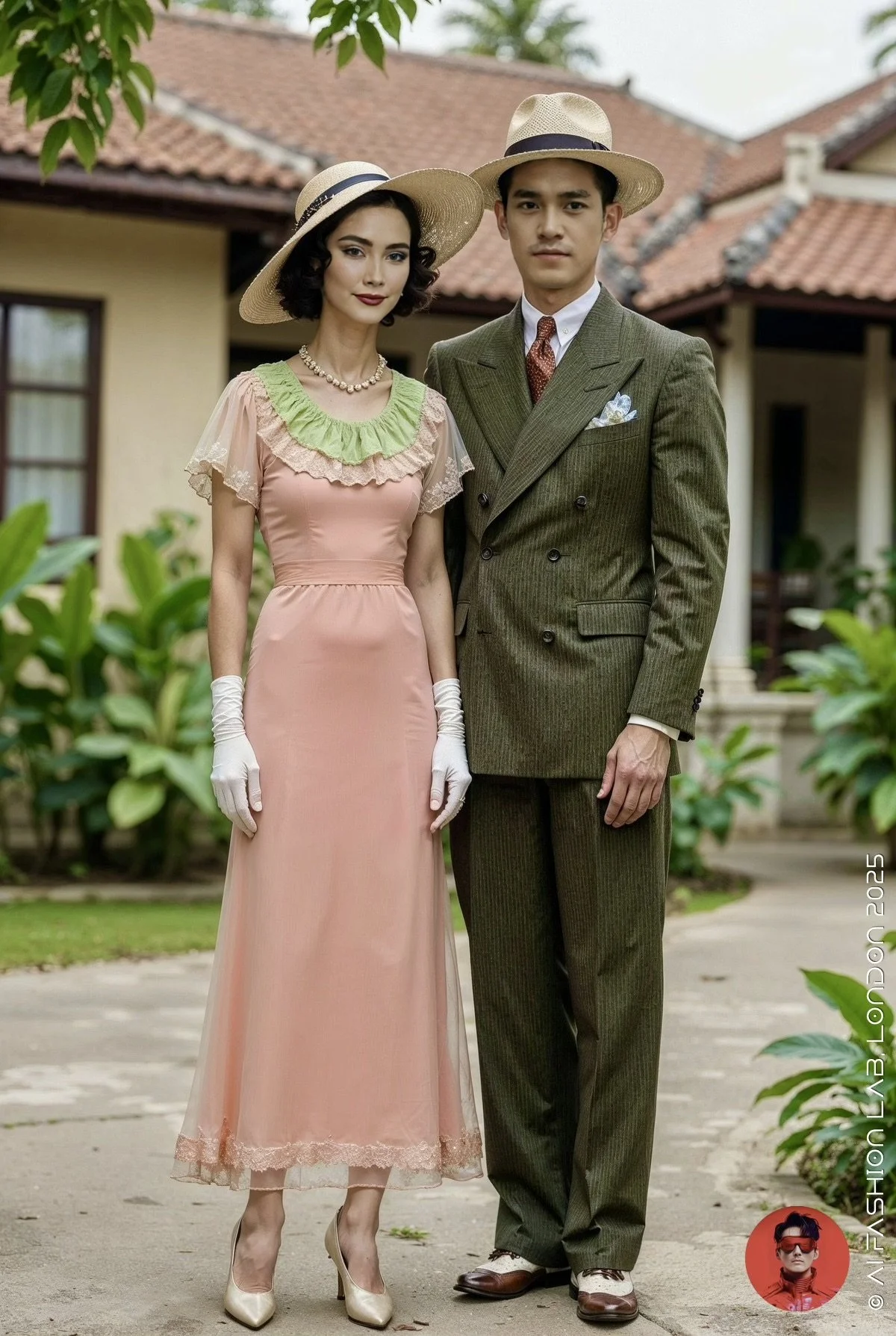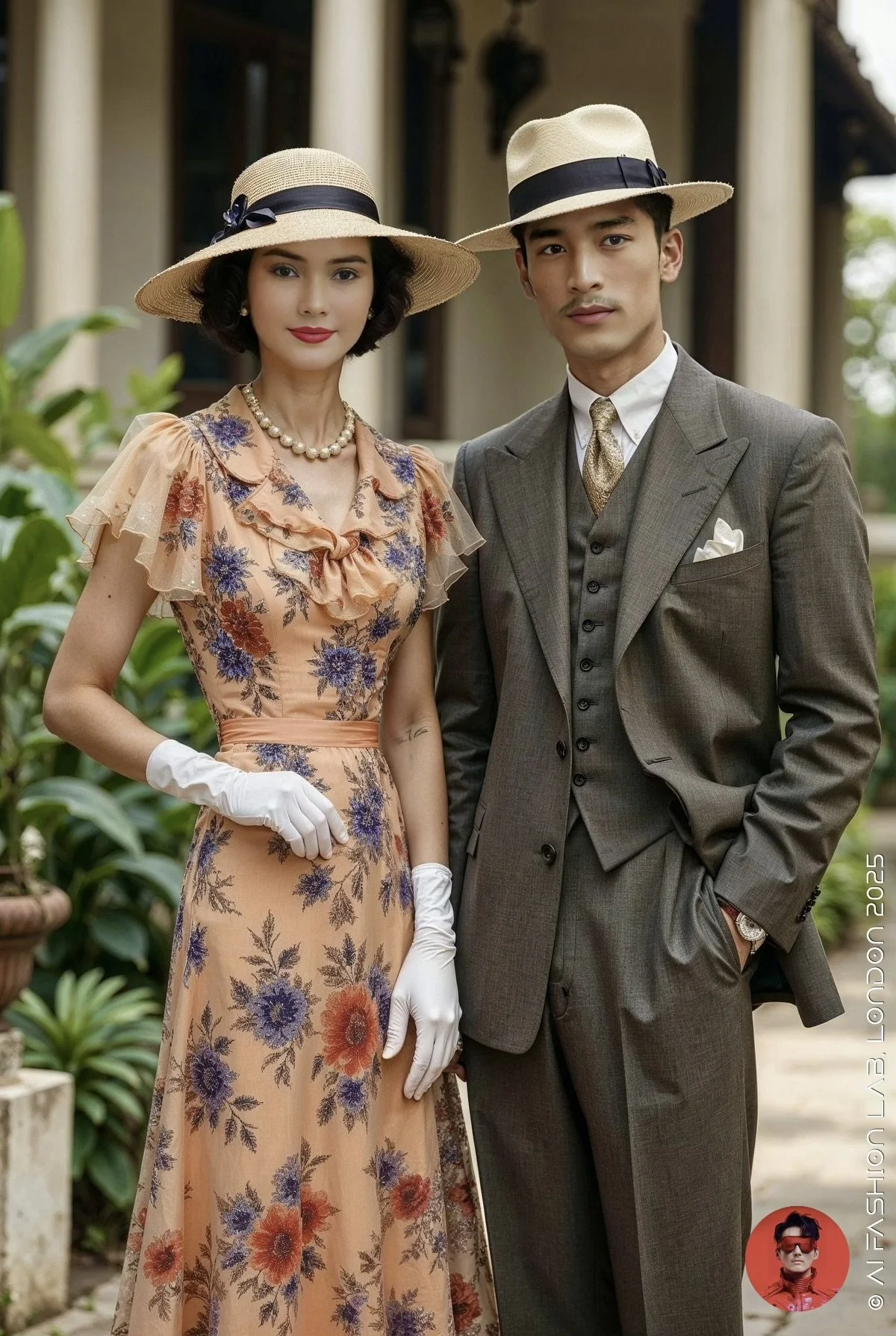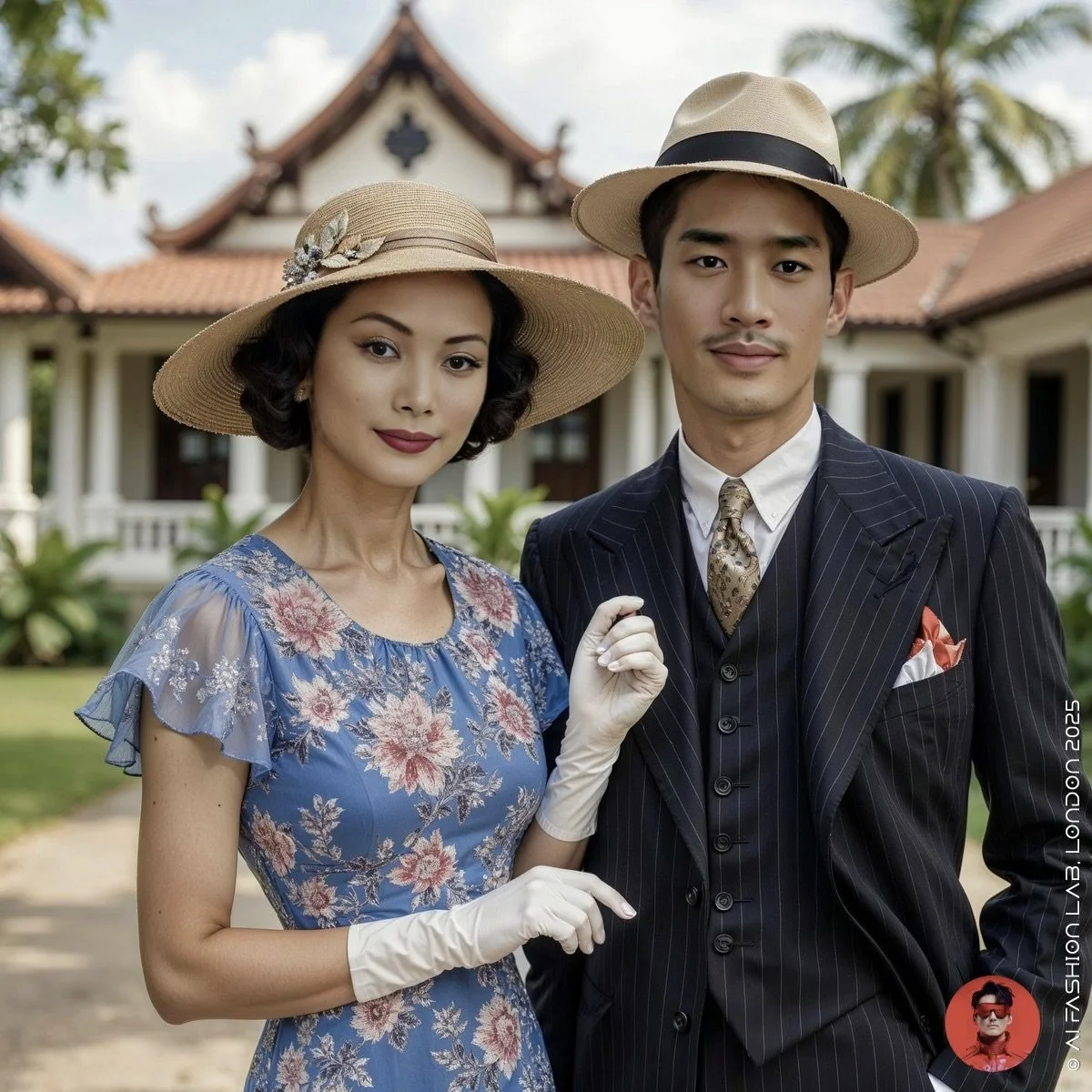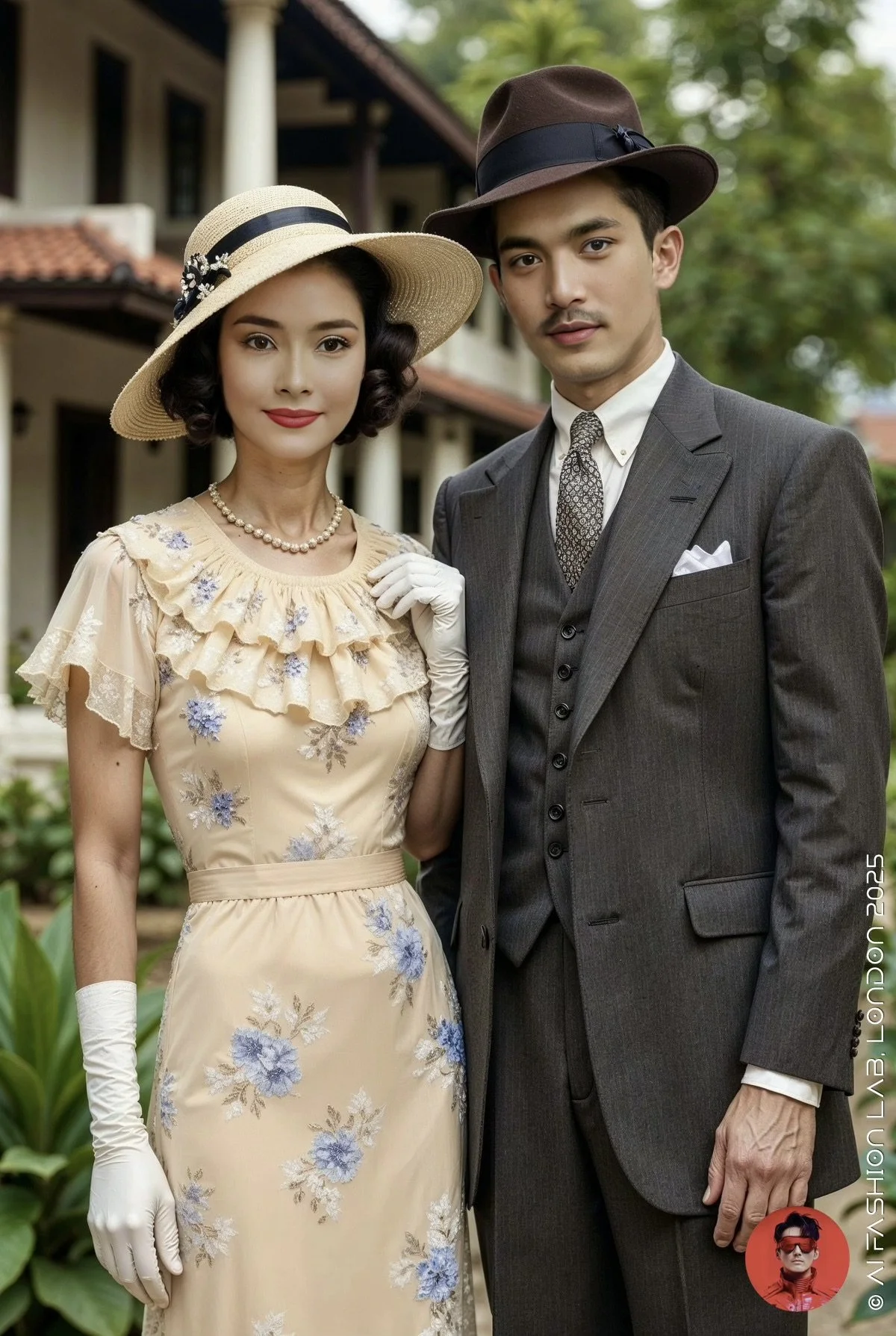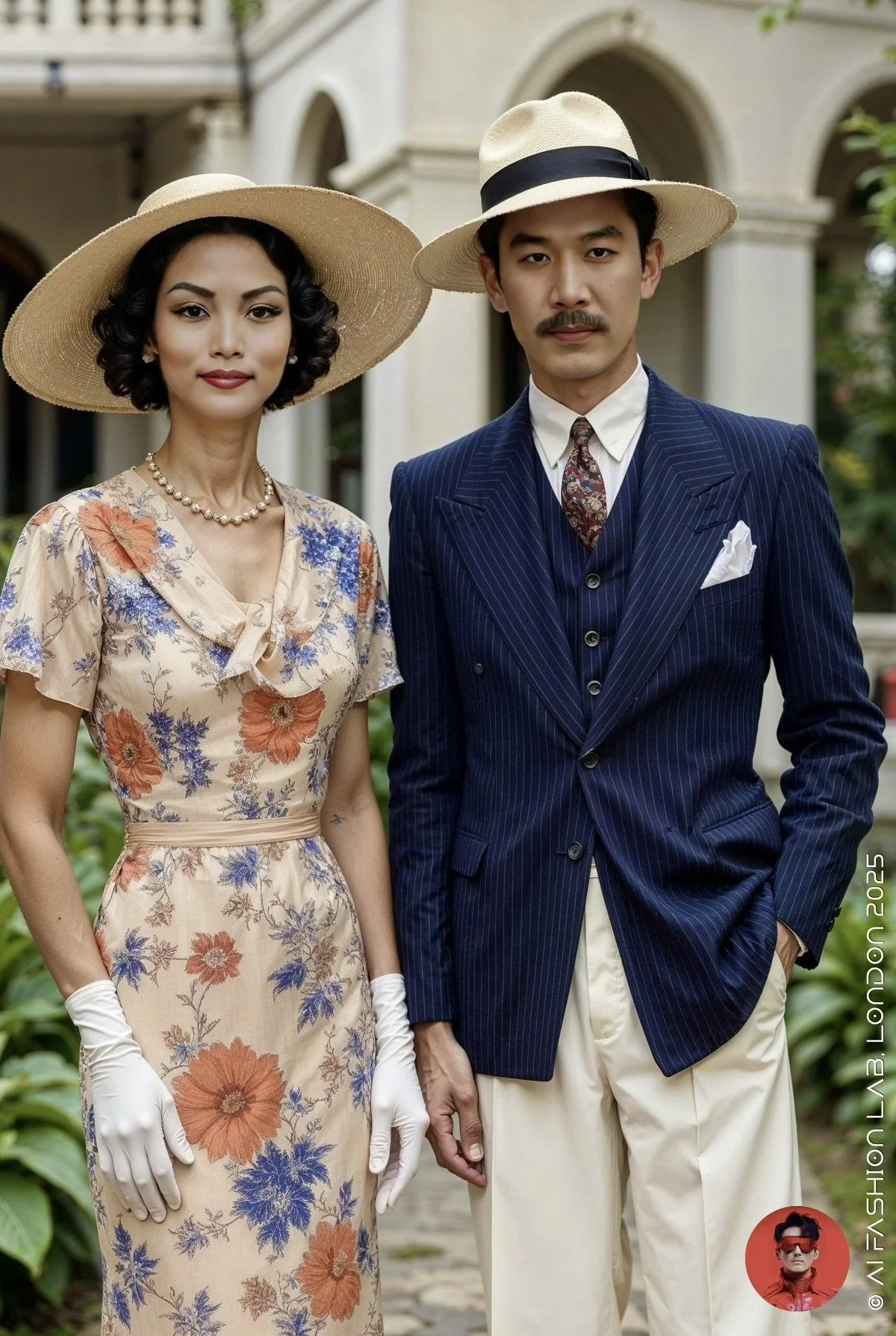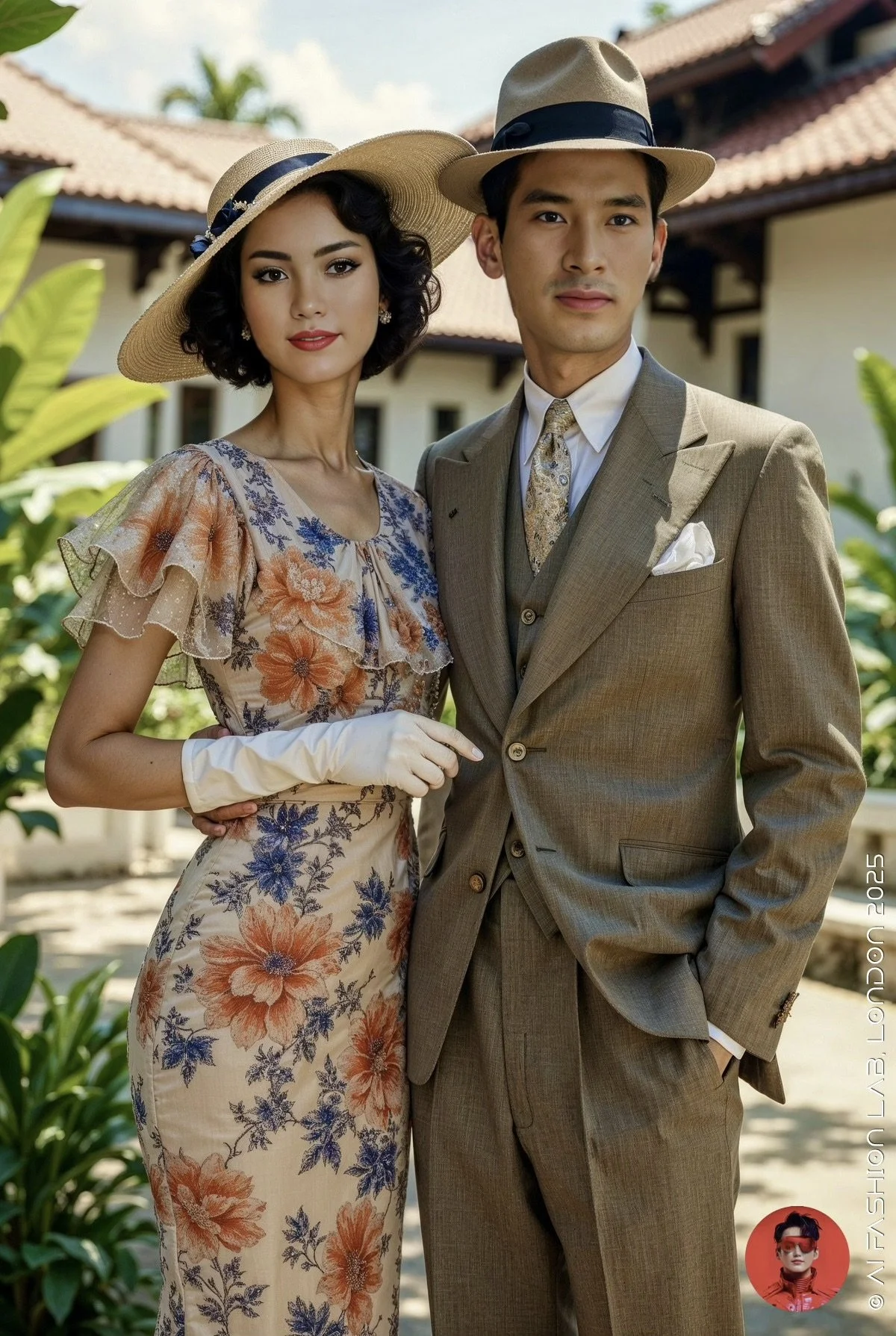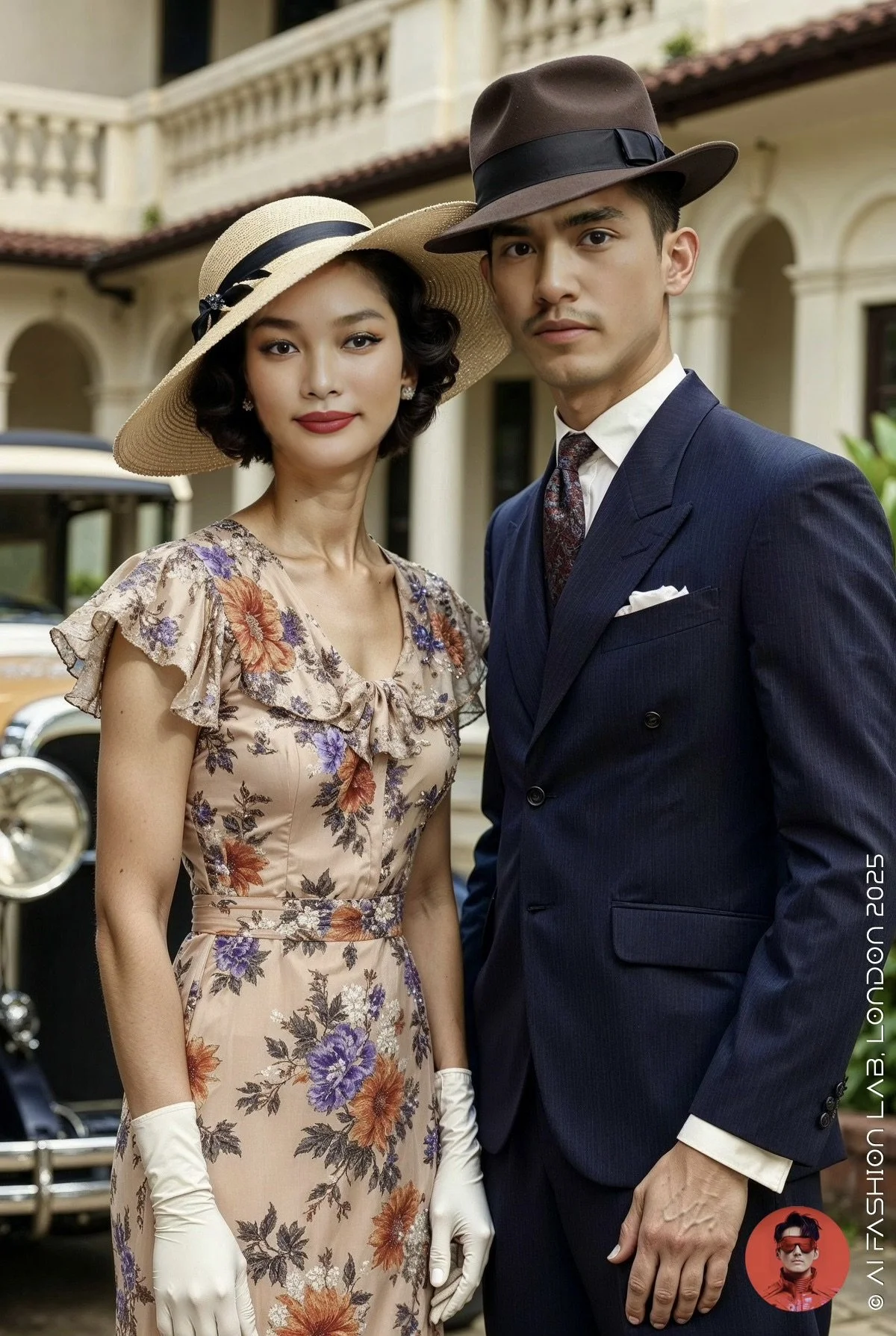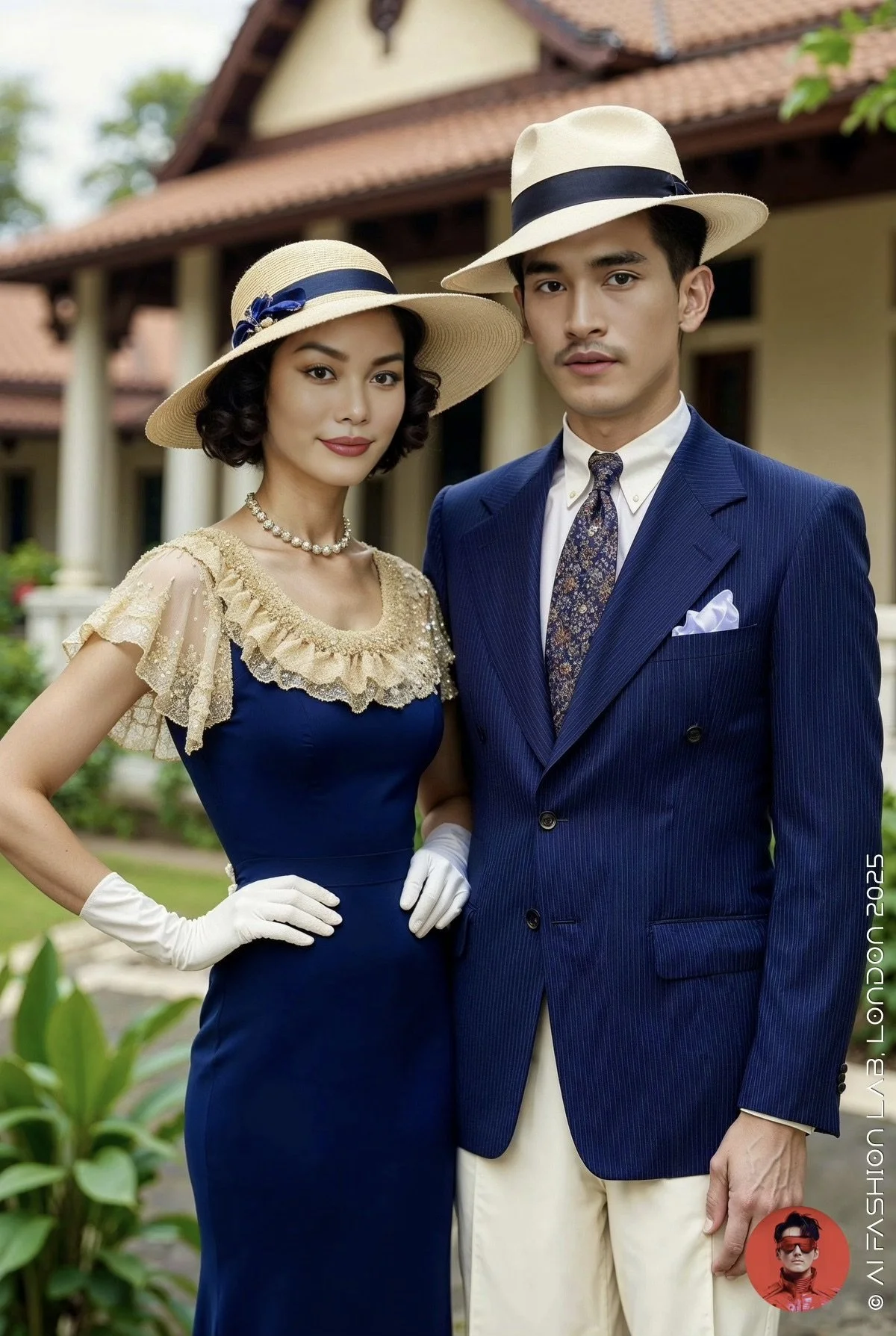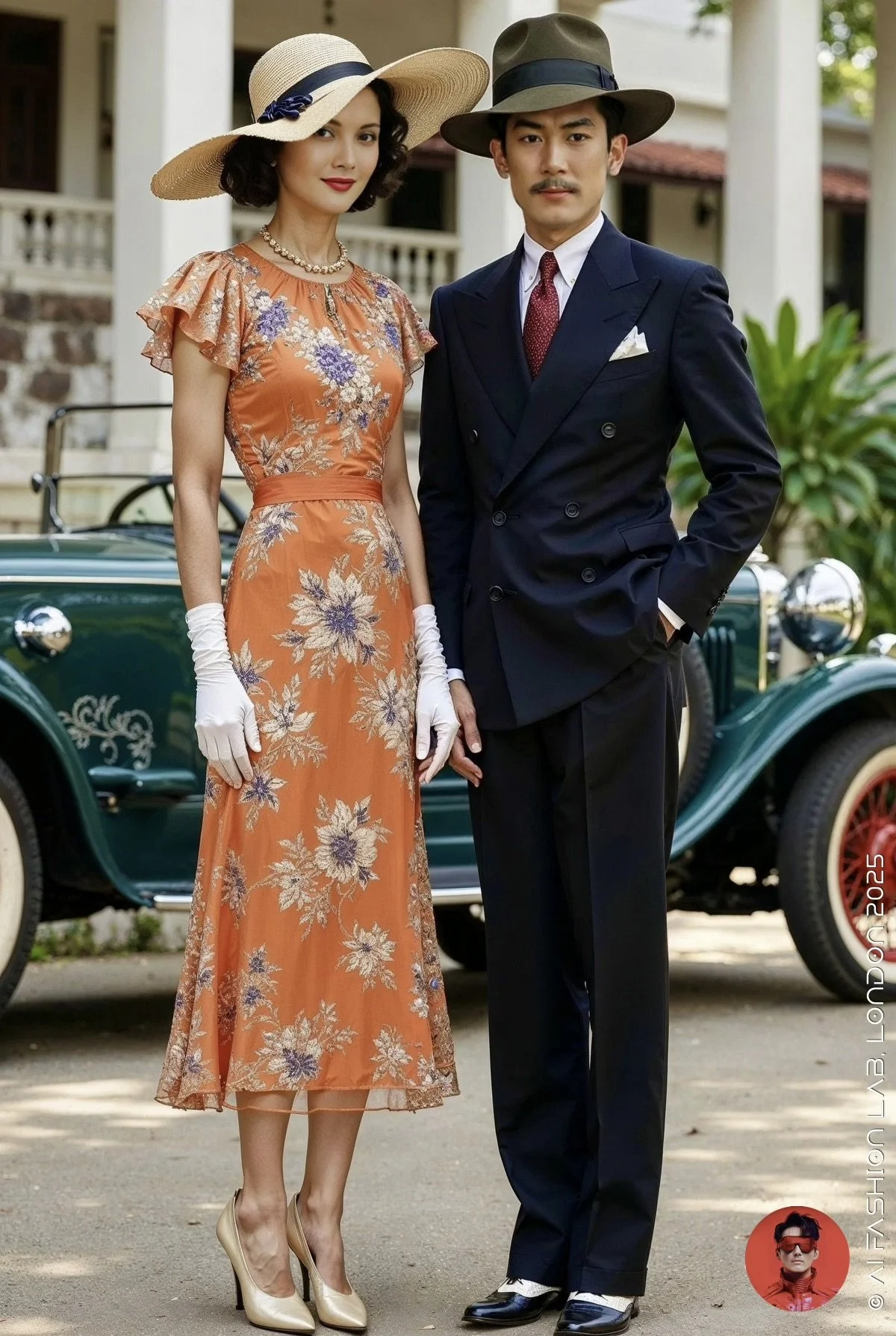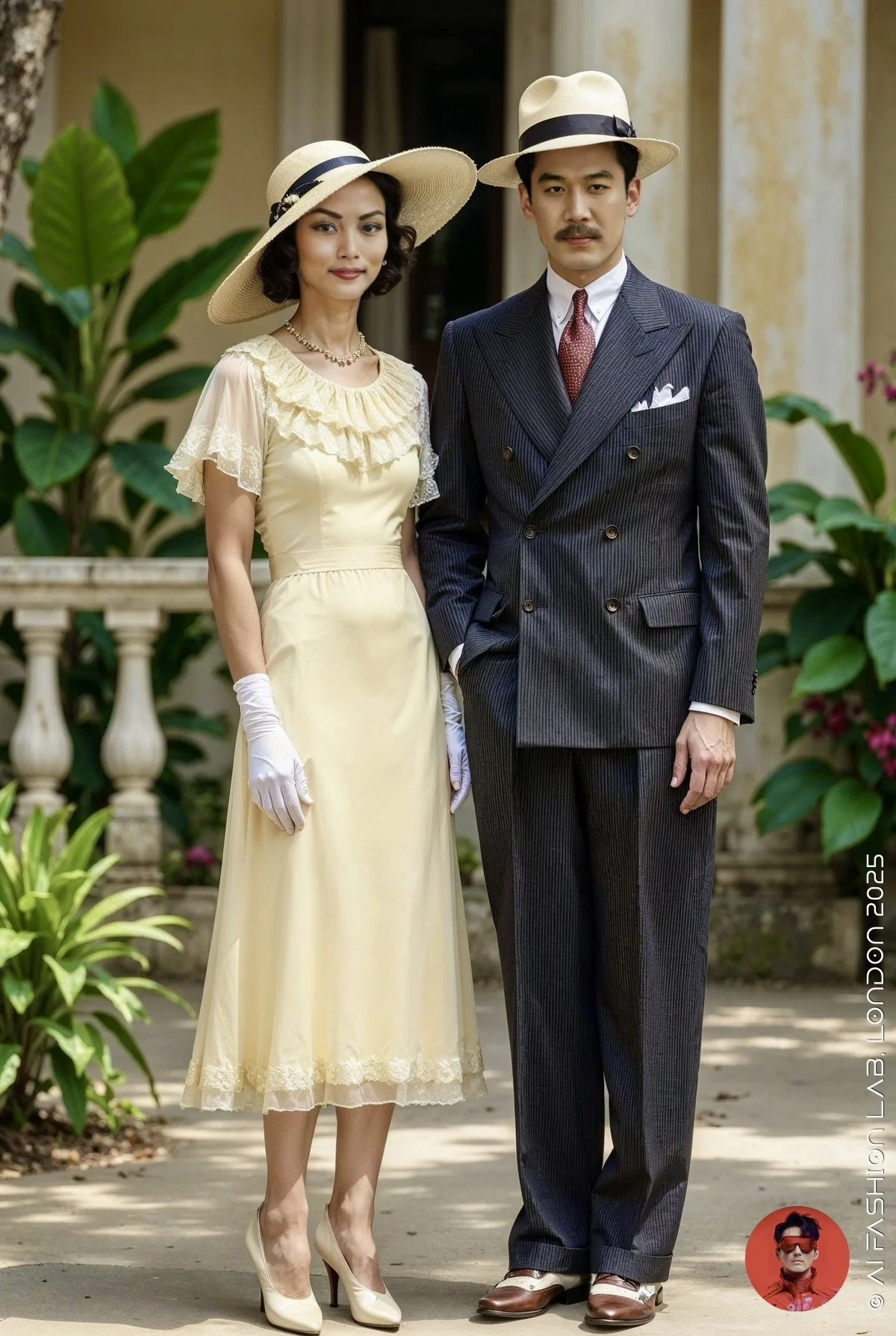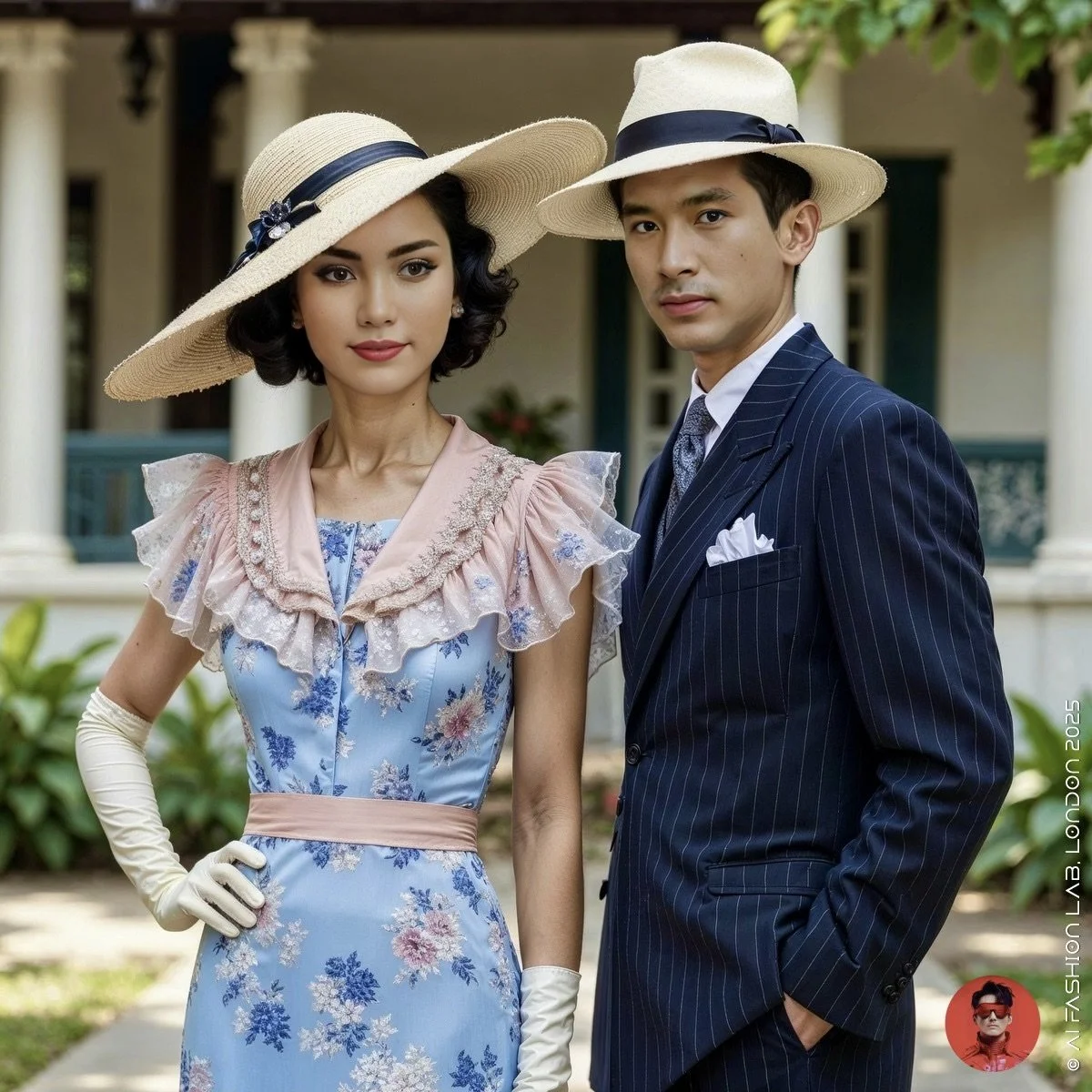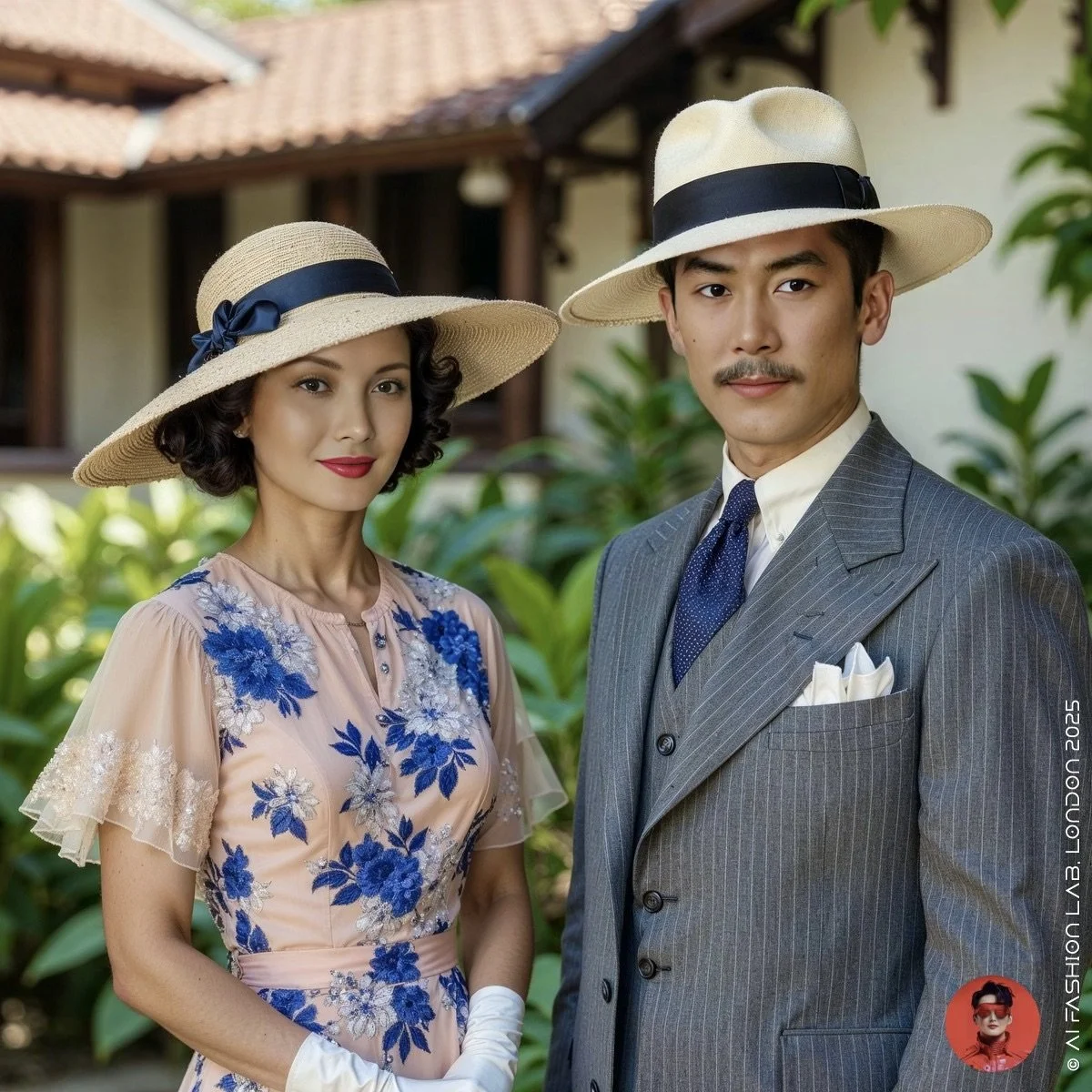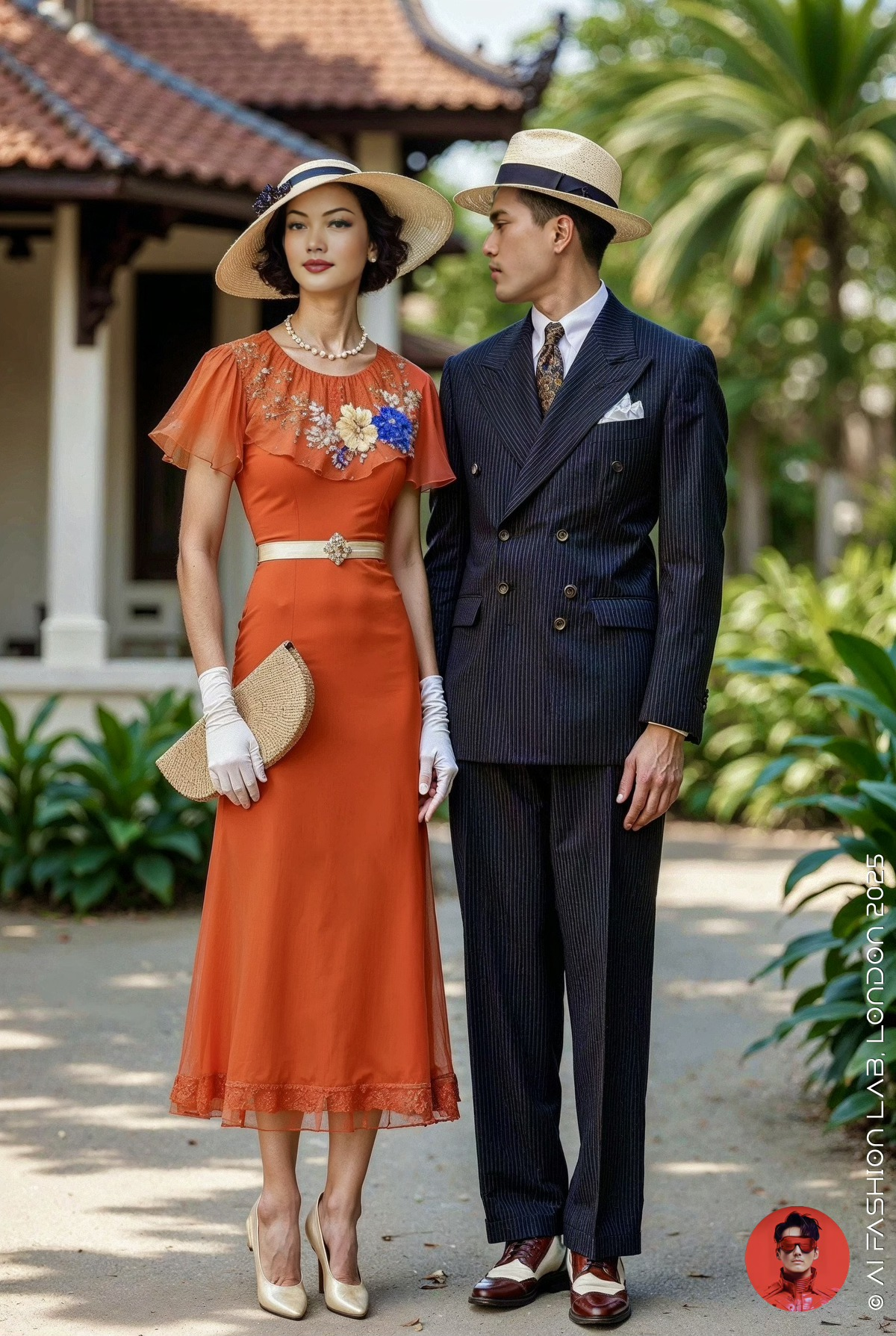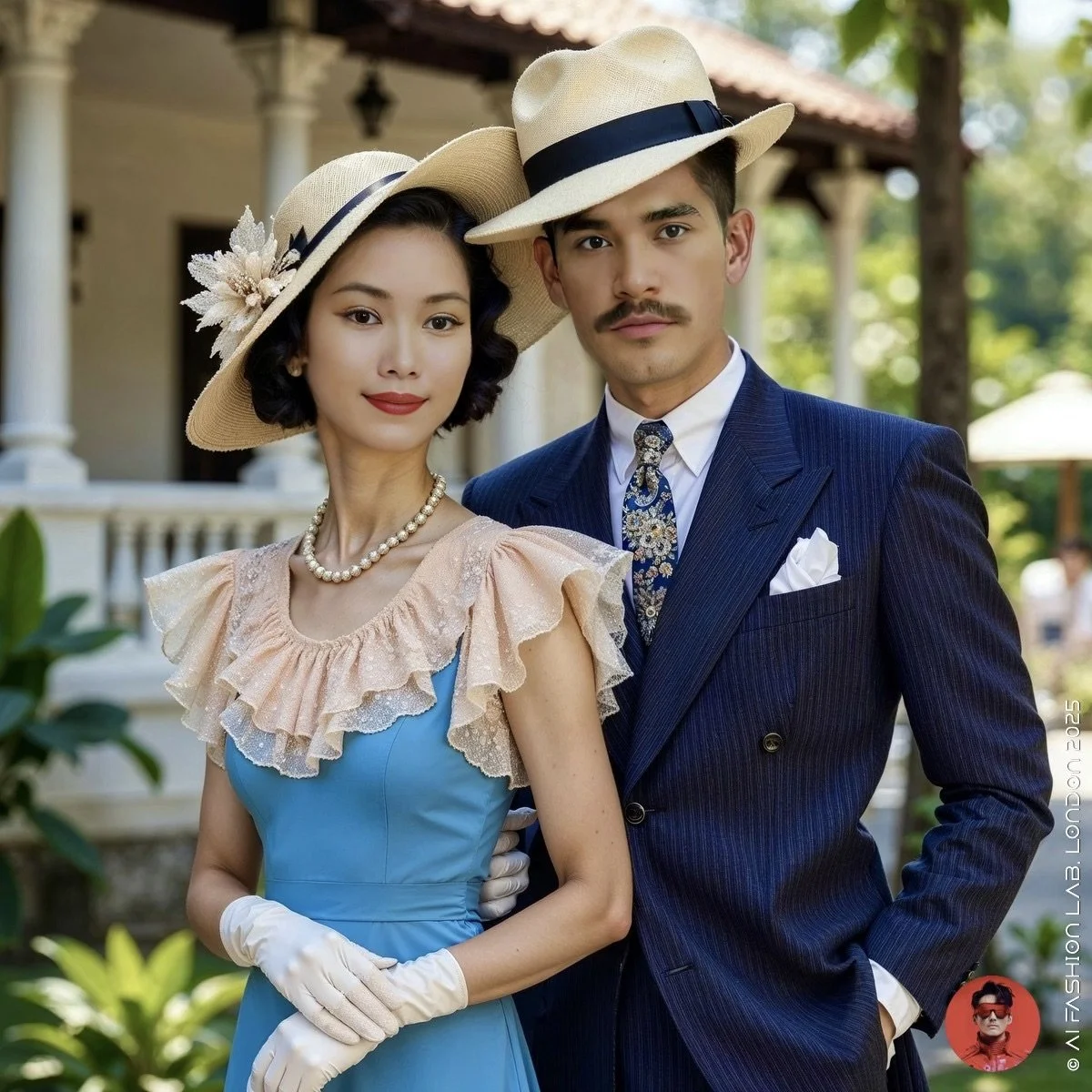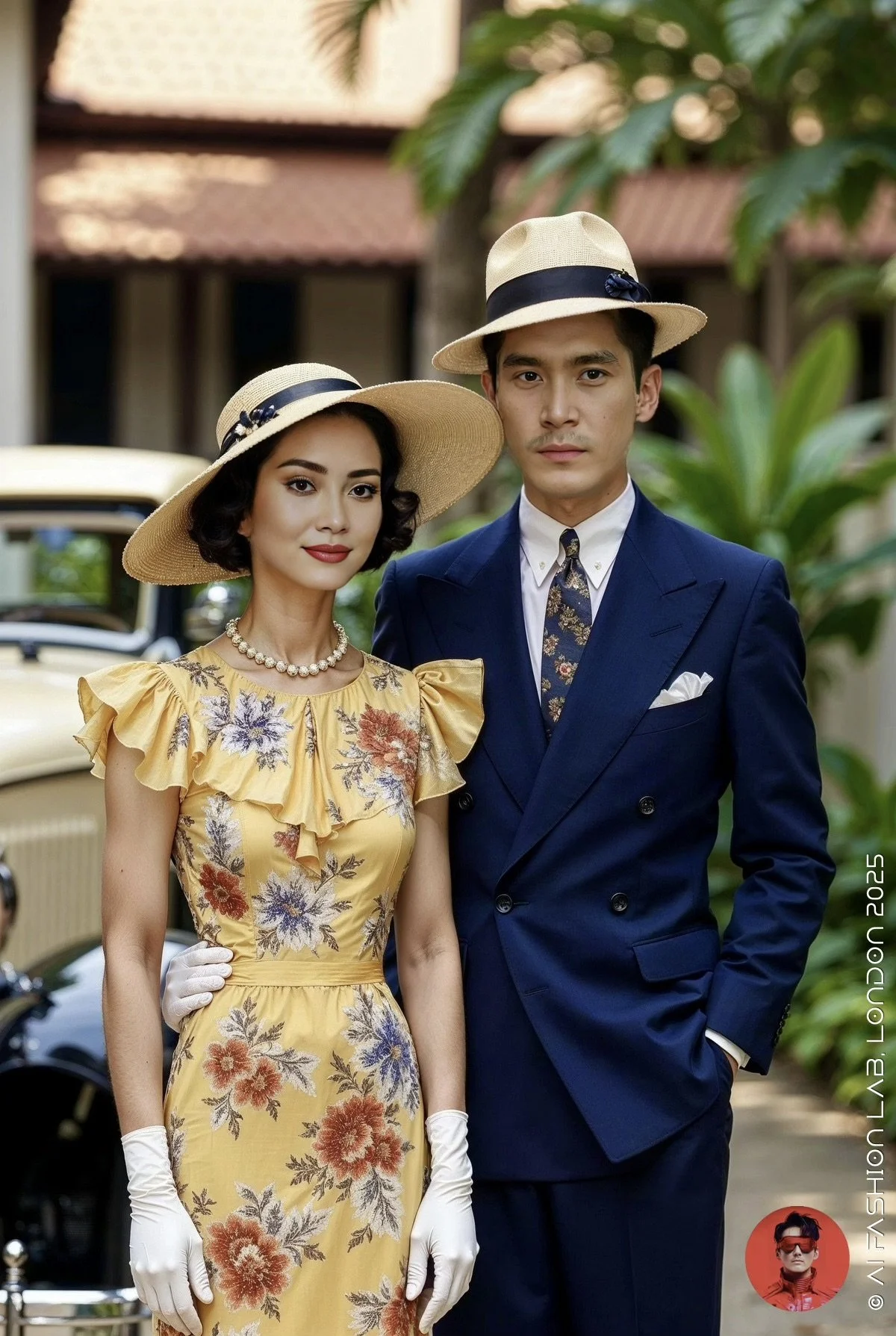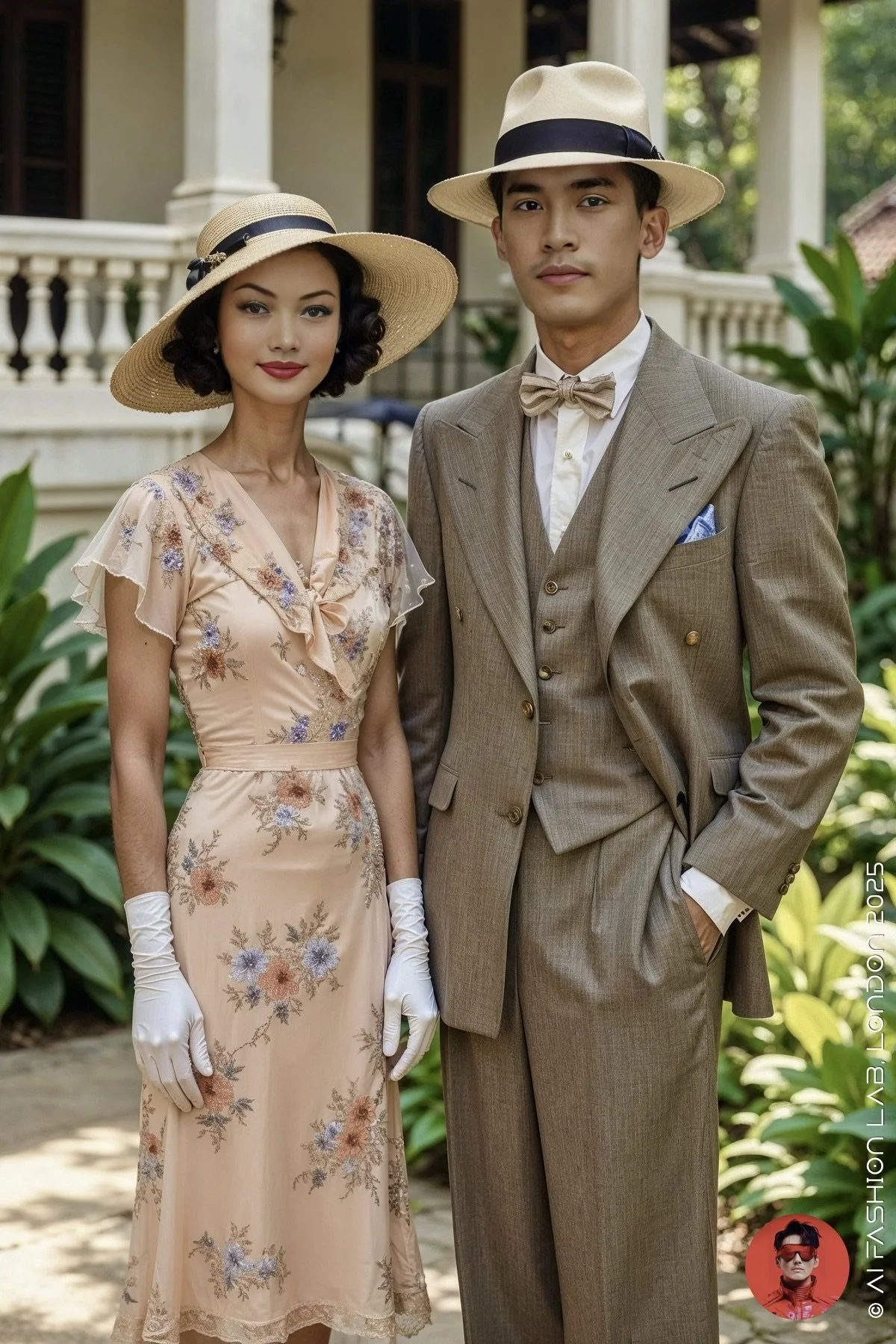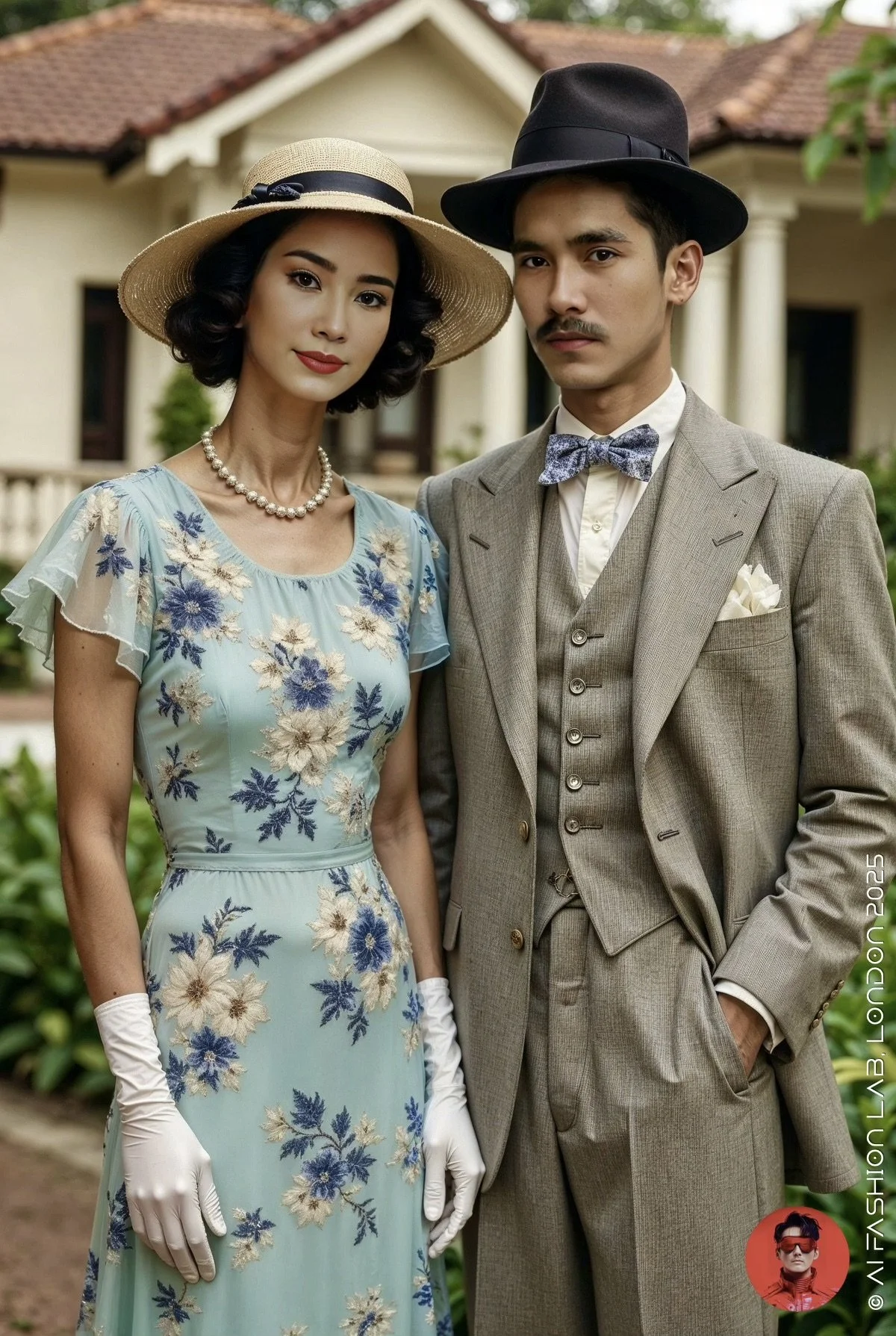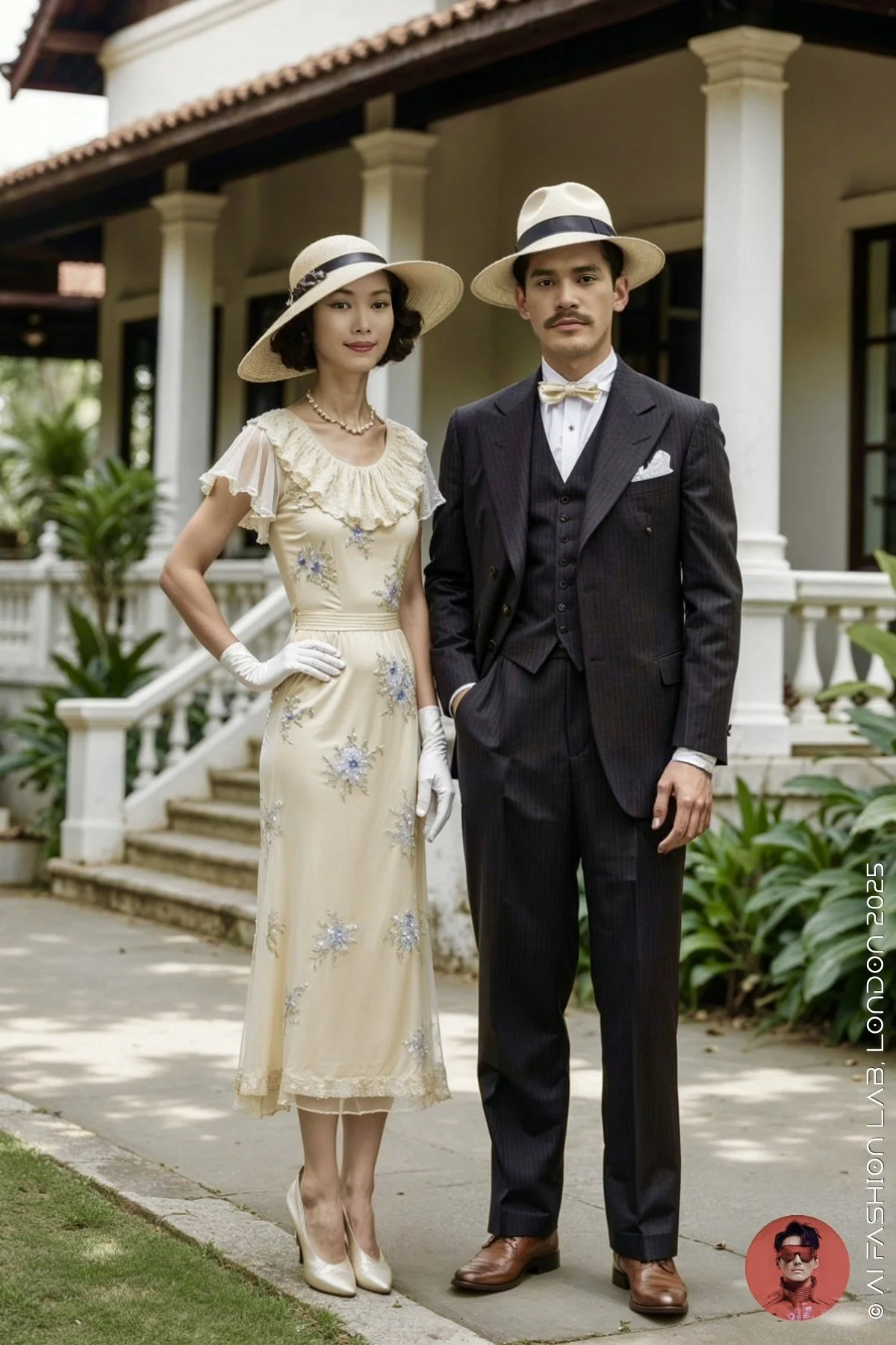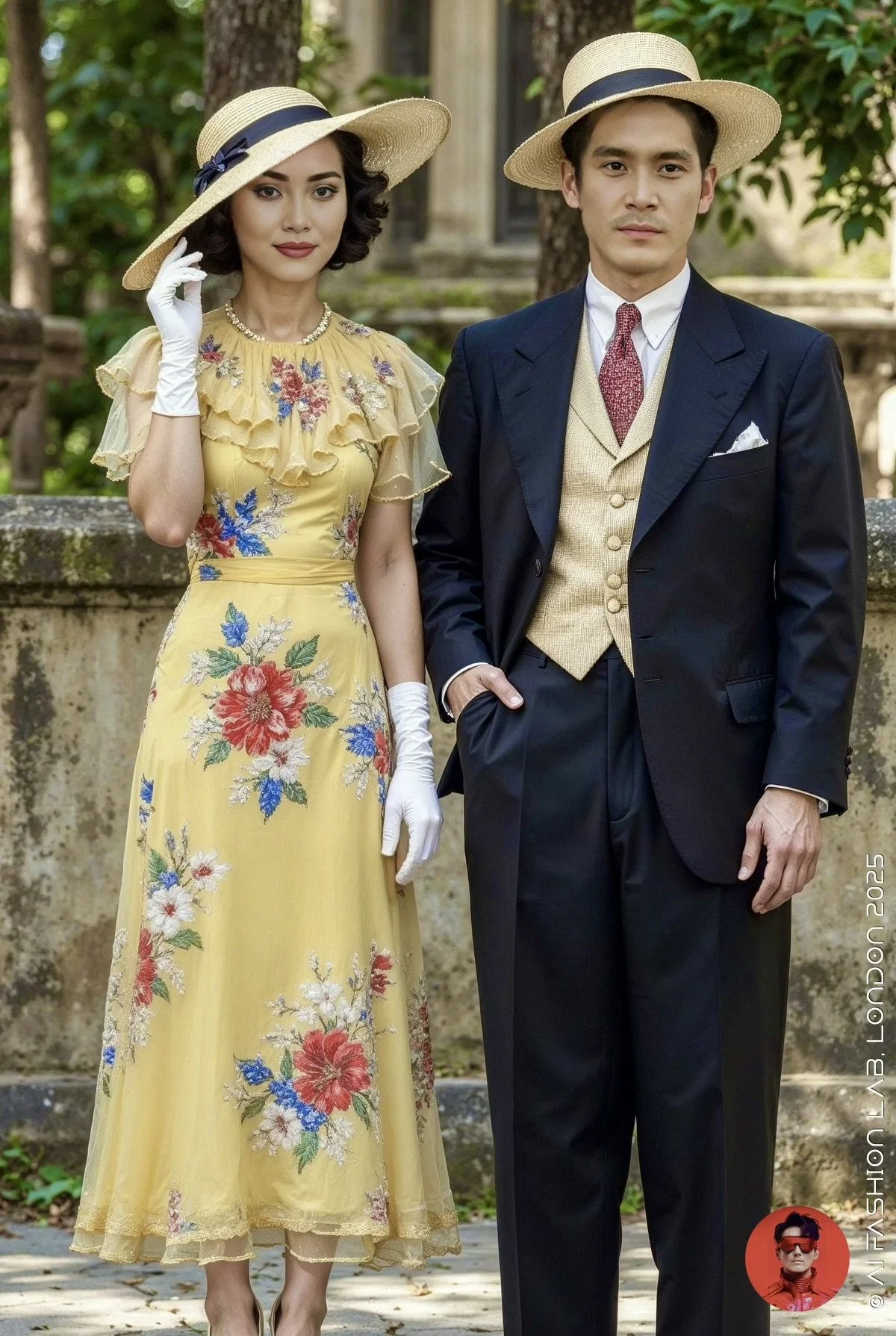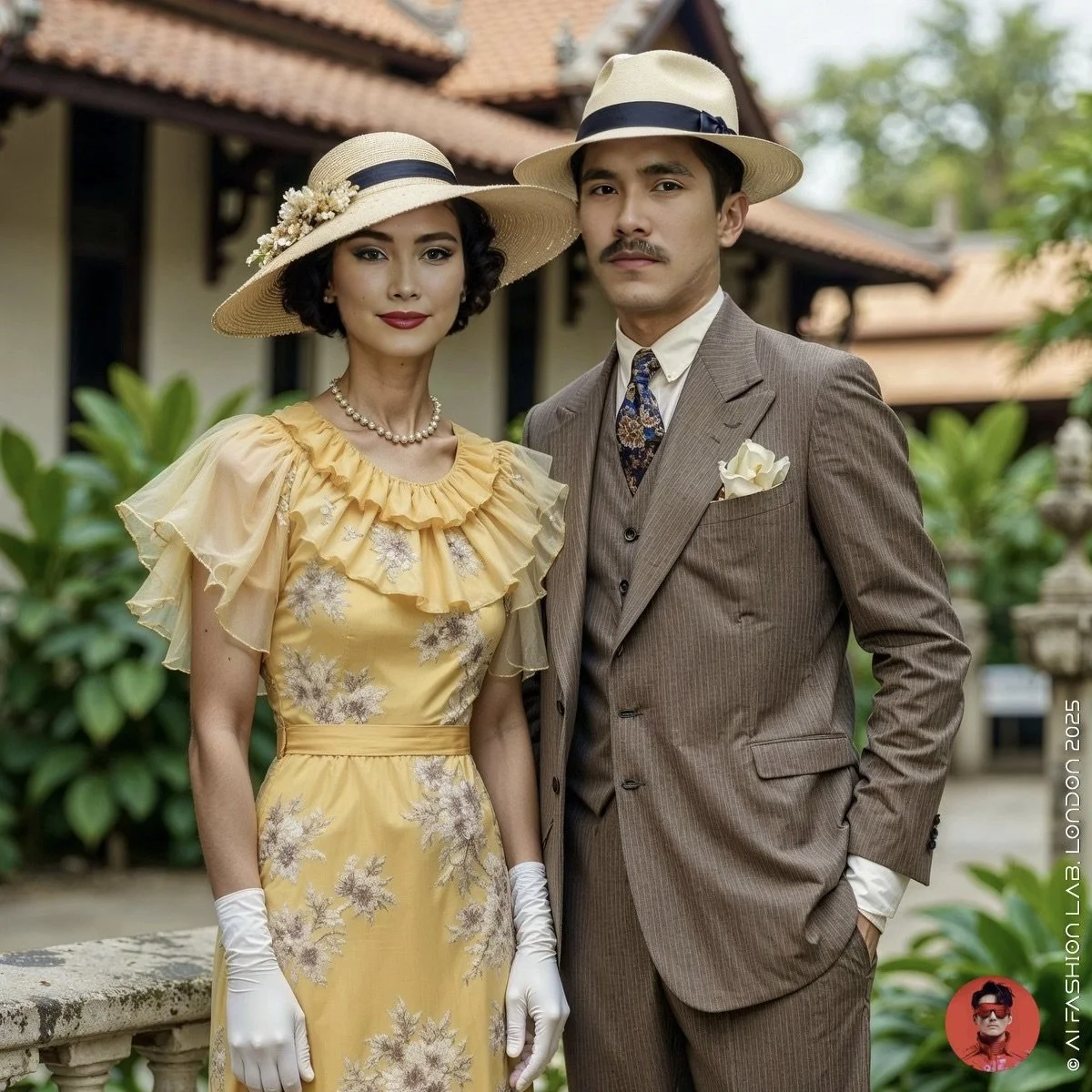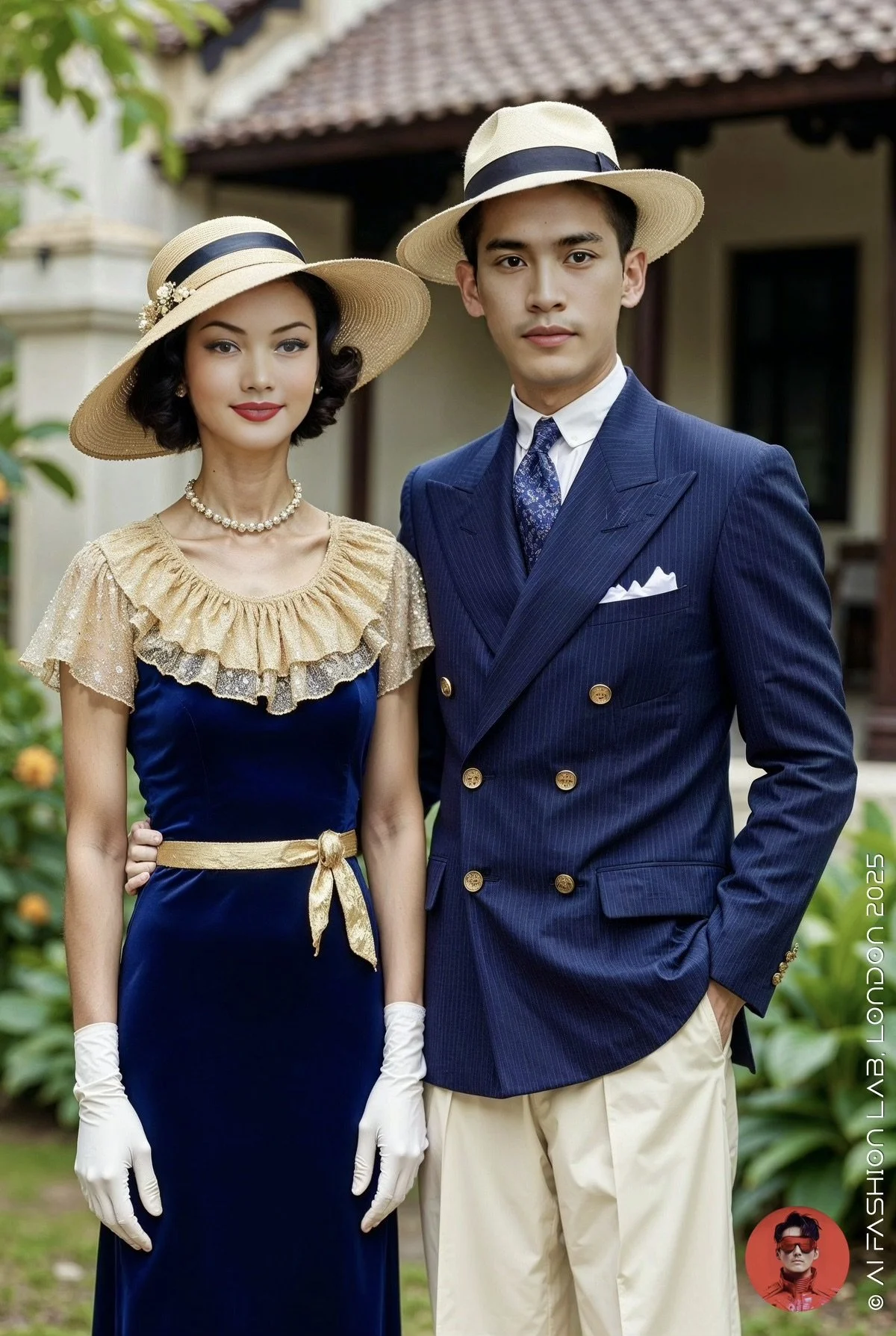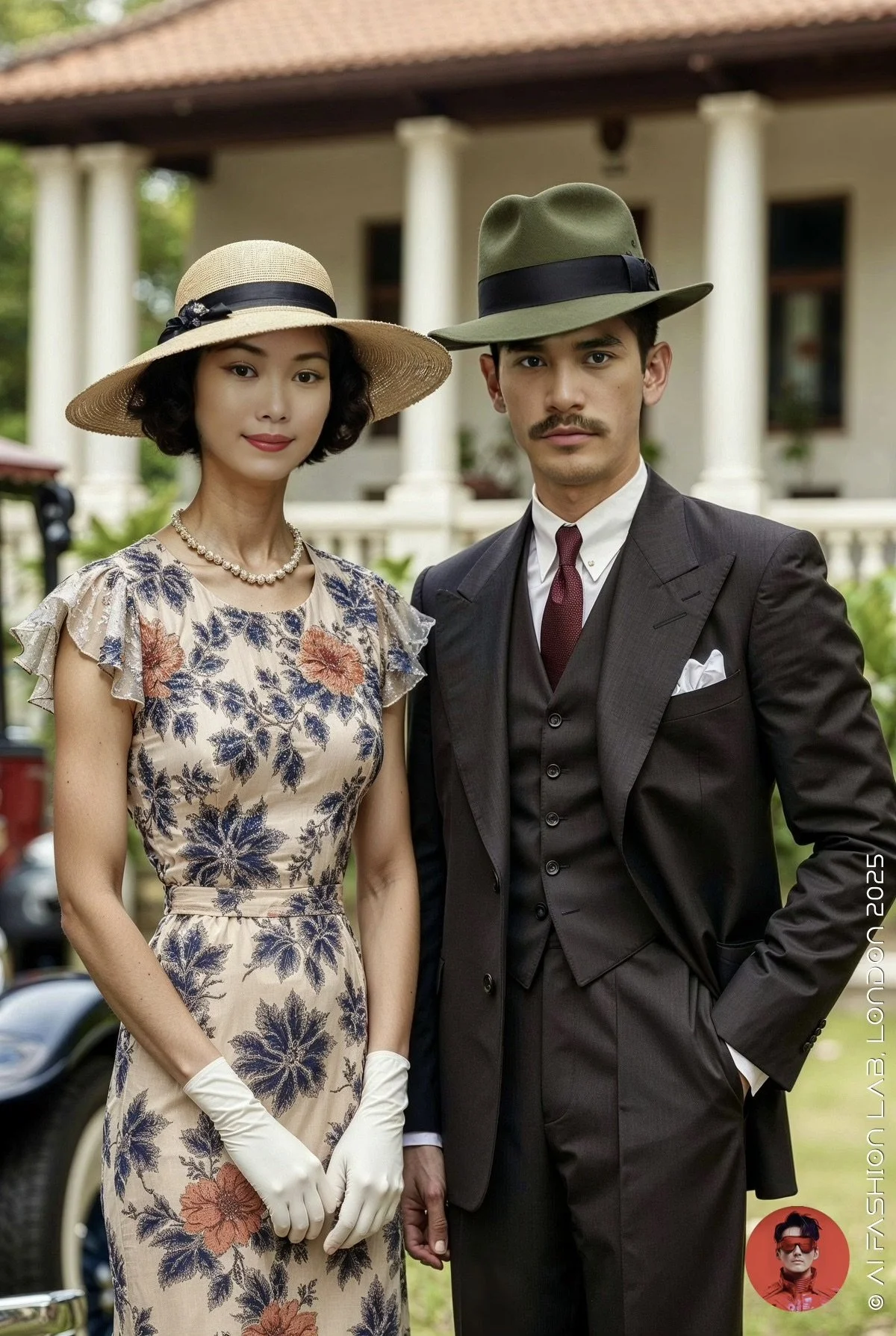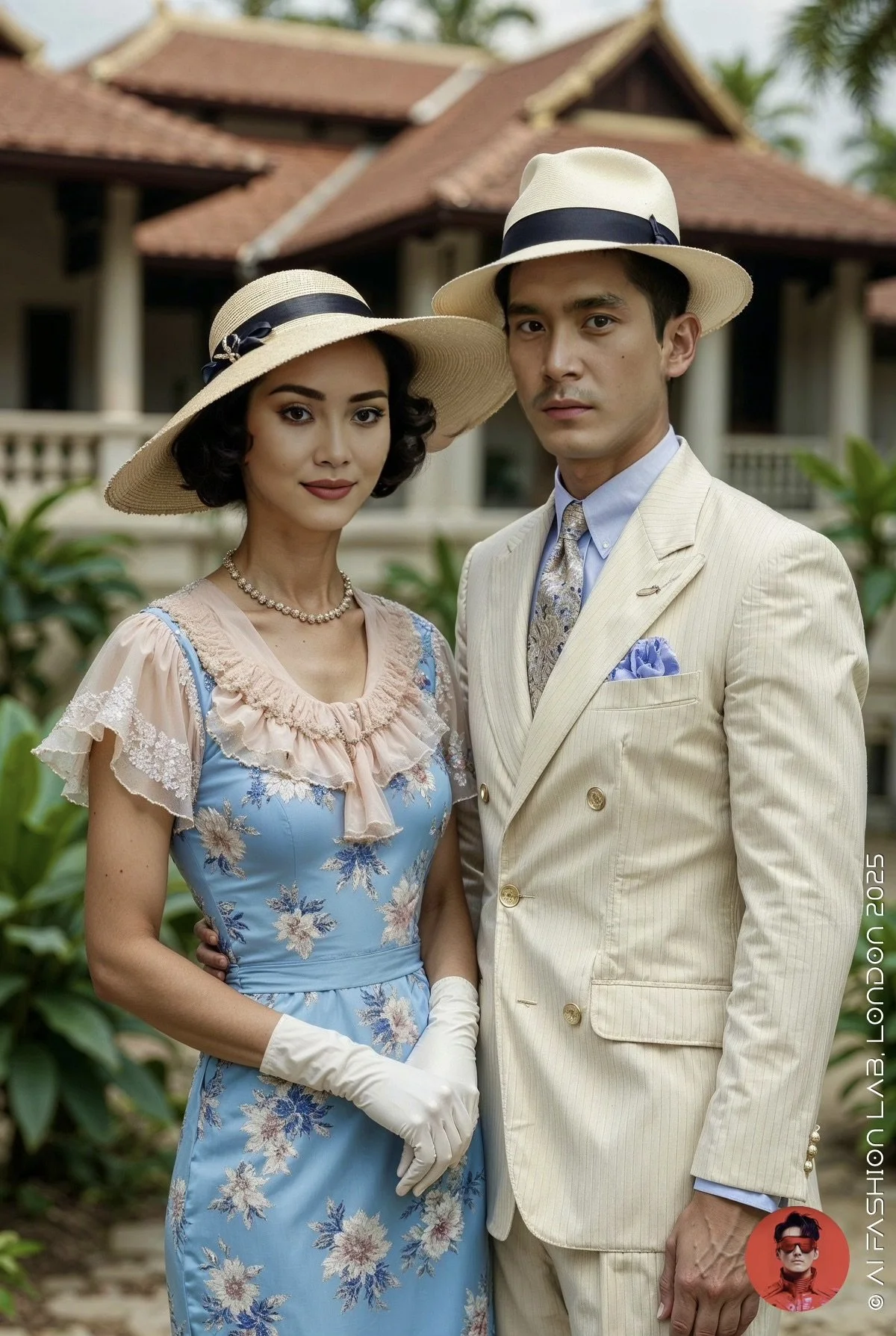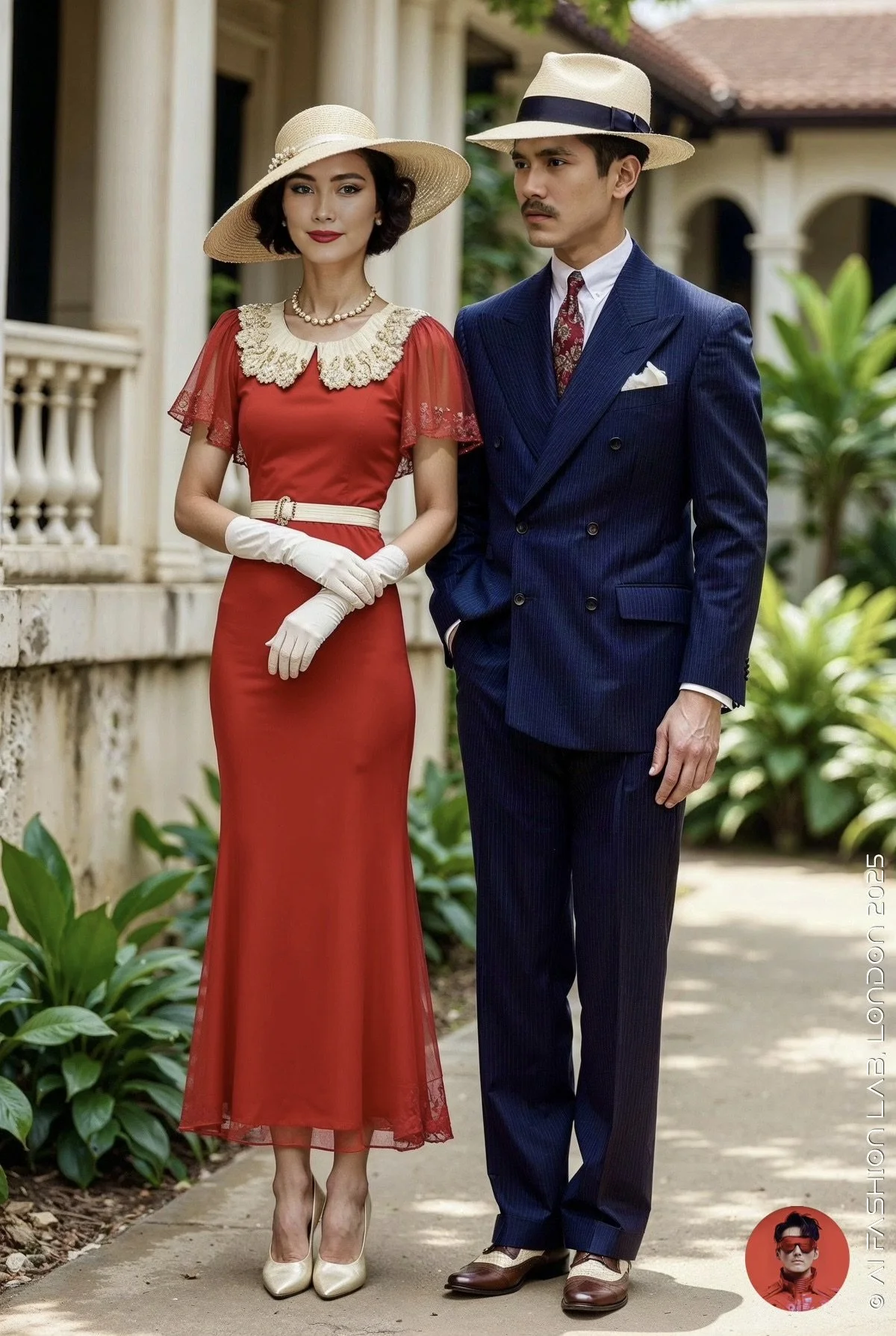สยามในปี พ.ศ. 2478: ภาพลักษณ์ของชาติ จากแฟชั่นถึงโบราณสถาน
สยามในปี พ.ศ. 2478: ภาพลักษณ์ของชาติ จากแฟชั่นถึงโบราณสถาน
คอลเลกชันแฟชั่น AI: สยามในปี พ.ศ. 2478 – วิสัยทัศน์แห่งความงามและอารยธรรมก่อนสงครามโลก
คอลเลกชันแฟชั่น AI ชุดนี้จินตนาการถึงการแต่งกายของสุภาพบุรุษและสุภาพสตรีไทยในปี พ.ศ. 2478 ซึ่งอยู่ในรัชสมัยของพระบาทสมเด็จพระปกเกล้าเจ้าอยู่หัว (รัชกาลที่ 7 ครองราชย์ พ.ศ. 2468–2477) ปี พ.ศ. 2478 ถือเป็นช่วงหัวเลี้ยวหัวต่อ ทั้งในด้านแฟชั่นและมรดกวัฒนธรรมของชาติ เนื่องจากเป็นปีที่ ปราสาทตาเมือนธม ได้รับการขึ้นทะเบียนเป็นโบราณสถานของไทย — เกือบสองทศวรรษก่อนที่ประเทศกัมพูชาจะได้รับเอกราชจากการเป็นอาณานิคมของฝรั่งเศส
สไตล์สุภาพสตรี: อ่อนช้อยและสง่างามในแบบสากล
แฟชั่นสตรีในยุค 1930s ถือเป็นช่วงเปลี่ยนผ่านจากซิลูเอตต์ทรงตรงและเลขาคณิตของยุค 1920s สู่โครงชุดที่เน้นความอ่อนหวานและเสริมสรีระมากขึ้น กระโปรงยาวระดับกลางน่อง แขนเสื้อระบายหรือผ้าโปร่ง คอเสื้อตกแต่งด้วยลูกไม้หรือลูกปัด หมวกปีกกว้าง ถุงมือไข่มุก และรองเท้าหัวมน ล้วนเป็นองค์ประกอบสำคัญของสไตล์สตรีในยุคนี้
ผมจินตนาการว่าสตรีในสยาม ณ ขณะนั้นนิยมแต่งกายตามแบบตะวันตก เพื่อสะท้อนภาพลักษณ์ของความเรียบร้อย สุภาพ และงดงามในกรอบความงามแบบสากล
สุภาพบุรุษไทย: ความสง่างามแห่งความคลาสสิก
สำหรับบุรุษ คอลเลกชันนี้เลือกนำเสนอ “ชุดสูทสามชิ้นแบบปกไขว้” (three-piece suit with peak lapel) ซึ่งเป็นแบบฉบับของแฟชั่นบุรุษในยุค 1930s เสริมบุคลิกด้วยหมวกเฟโดรา หรือหมวกปานามา และรองเท้าหนังทูโทนทรงคลาสสิก
แฟชั่นดังกล่าวสะท้อนถึงการปรับใช้สไตล์ตะวันตกในหมู่ชนชั้นสูงของไทยในกรุงเทพฯ ช่วงก่อนสงครามโลกครั้งที่ 2 และกลายเป็นรากฐานของสไตล์สุภาพบุรุษที่ยังคงเป็นอมตะจวบจนปัจจุบัน
บริบทประวัติศาสตร์: ปราสาทตาเมือนธม ก่อนกัมพูชาจะได้รับเอกราช
ปราสาทตาเมือนธม ตั้งอยู่ในเขตแดนประเทศไทย และได้รับการขึ้นทะเบียนเป็นโบราณสถานโดยกรมศิลปากรในปี พ.ศ. 2478 (ค.ศ. 1935) หรือเมื่อ 90 ปีมาแล้ว ปัจจุบันอยู่ภายใต้การดูแลของสำนักศิลปากรที่ 5 จังหวัดปราจีนบุรี
การขึ้นทะเบียนครั้งนั้นเกิดขึ้นล่วงหน้ากว่า 20 ปี ก่อนที่ประเทศกัมพูชาจะได้รับเอกราชจากฝรั่งเศสในปี พ.ศ. 2496 และได้รับการรับรองจากองค์การสหประชาชาติในปี พ.ศ. 2498
ตลอดหลายทศวรรษที่ผ่านมา ประเทศไทยได้ดำเนินการอนุรักษ์โบราณสถานแห่งนี้อย่างต่อเนื่อง ทั้งการบูรณะโดยกรมศิลปากร และการพัฒนาเส้นทางท่องเที่ยวโดยการท่องเที่ยวแห่งประเทศไทย โดยทางการกัมพูชาก็รับทราบกระบวนการเหล่านี้มาโดยตลอด
อย่างไรก็ตาม ในช่วงหลัง กัมพูชากลับพยายามอ้างสิทธิเหนือพื้นที่ดังกล่าว ด้วยการปลุกกระแสชาตินิยม ซึ่งมีลักษณะคล้ายคลึงกับข้อพิพาทกรณี “ปราสาทพระวิหาร” ทั้งที่ความจริง เส้นเขตแดนบริเวณนี้อิงตามหลัก “สันปันน้ำ” ซึ่งเป็นมาตรฐานสากลที่ชัดเจนว่าพื้นที่ดังกล่าวอยู่ในอาณาเขตประเทศไทย
ปัจจุบัน: มรดกทางวัฒนธรรม ท่ามกลางสถานการณ์ชายแดน
ในขณะนี้เขมรได้ทำการรุกรานประเทศไทย ประเทศไทยจึงมีความจำเป็นต้องยืนยันสิทธิอธิปไตยเหนือดินแดนและโบราณสถานในเขตแดนของตนอย่างชัดเจน ท่ามกลางกระแสชาตินิยมและวาทกรรมทางการเมืองจากฝ่ายกัมพูชา
การที่ประเทศไทยได้ขึ้นทะเบียนปราสาทตาเมือนธมเป็นโบราณสถานตั้งแต่ปี พ.ศ. 2478 — ก่อนที่กัมพูชาจะได้รับเอกราชจากฝรั่งเศสถึงสองทศวรรษ — ไม่เพียงแต่เป็นหลักฐานเชิงประวัติศาสตร์และกฎหมาย หากยังสะท้อนถึงความรับผิดชอบที่ไทยได้แสดงตลอดหลายทศวรรษ ในการดูแล รักษา และเผยแพร่มรดกทางวัฒนธรรมของภูมิภาคนี้ด้วยความเคารพและวิสัยทัศน์สากล
หมายเหตุ: ภาพในคอลเลกชันนี้เป็นการจินตนาการเชิงสร้างสรรค์จากข้อมูลทางประวัติศาสตร์และการศึกษาด้านแฟชั่น โดยใช้เทคโนโลยี AI เพื่อจำลองเครื่องแต่งกายให้มีรายละเอียดใกล้เคียงกับยุคสมัยนั้นมากที่สุด ทั้งในด้านซิลูเอตต์ สีผ้า ทรงผม และอุปกรณ์ประกอบฉาก
แหล่งอ้างอิงเพิ่มเติม
Fashioning 1935: Siam’s Sartorial Identity Amid Cultural Milestones
This AI fashion collection envisions the attire of Thai gentlemen and gentlewomen in the year 1935, during the reign of His Majesty King Prajadhipok (Rama VII, who reigned from 1925 to 1934). The year 1935 marked a significant turning point—not only in terms of fashion but also in the realm of cultural heritage—being the year that Prasat Ta Muen Thomwas officially registered as a historic site of Thailand, nearly two decades before Cambodia gained independence from French colonial rule.
Ladies’ Fashion: Graceful and Elegantly International
Women’s fashion of the 1930s was a transitional period, moving away from the straight, geometric silhouettes of the 1920s towards softer, more body-conscious forms. Mid-calf-length dresses, flutter or sheer sleeves, delicately embellished collars with lace or beading, wide-brimmed hats, pearl gloves, and rounded-toe shoes were all key elements of feminine style in this era.
I imagined that middle-class Siamese women of the time embraced Western dress codes to reflect an image of refinement, gentility, and elegance, in accordance with international ideals of beauty and decorum.
Thai Gentlemen: Timeless Sophistication in Classic Form
For men, this collection presents the classic three-piece suit with a peak lapel, a quintessential look of 1930s menswear. The outfit is completed with a fedora or Panama hat and two-tone leather shoes—accessories that amplify the gentlemanly aura of the era.
This style reflects the Western influence adopted by Thailand’s urban elite in Bangkok during the pre-World War II period, laying the foundation for a timeless silhouette that remains an enduring symbol of gentlemanly fashion to this day.
Historical Context: Prasat Ta Muen Thom Before Cambodian Independence
Prasat Ta Muen Thom, located within Thai territory, was registered as an official historic site by the Fine Arts Department of Thailand in 1935—ninety years ago. It is now under the care of the 5th Regional Office of Fine Arts, based in Prachinburi Province.
This registration took place more than 20 years before Cambodia gained independence from France in 1953 and was officially recognised by the United Nations in 1955.
Over the decades, Thailand has consistently preserved this ancient site—through restoration by the Fine Arts Department and the promotion of heritage tourism by the Tourism Authority of Thailand. These activities have been acknowledged by Cambodian authorities throughout this time.
However, in recent years, Cambodia has made renewed claims over this area, invoking nationalist rhetoric reminiscent of the Preah Vihear temple dispute. In reality, the boundary in this region follows the watershed principle, an internationally recognised standard which clearly places the site within Thai territory.
Present Day: Cultural Heritage Amid Border Tensions
As Cambodia launches its current incursion into Thai territory, it has become necessary for Thailand to firmly reaffirm its sovereignty over its borderlands and heritage sites—especially in the face of intensifying nationalist propaganda and political narratives from the Cambodian side.
Thailand’s registration of Prasat Ta Muen Thom as a historic monument in 1935—long before Cambodia became an independent state—is not only a matter of legal and historical record, but also a testament to Thailand’s longstanding responsibility in preserving and stewarding the region’s cultural heritage with dignity and international vision.
Note:
The images in this collection are artistic recreations informed by historical data and fashion studies. Using advanced AI technology, the clothing has been rendered with silhouette, fabric, hairstyles, and accessories as close as possible to what would have been worn during the era—providing a historically grounded yet imaginative glimpse into Siam’s fashion history before the Second World War.
#aifashionlab #AI #aiartist #aiart #aifashion #aifashiondesign #aifashionstyling #aifashiondesigner #fashion #fashionhistory #historyoffashion #fashionstyling #fashionphotography #digitalfashion #digitalfashiondesign #digitalcostumedesign #digitaldesign #digitalaiart #ThaiFashionHistory #ThaiFashionAI #thailand #UNESCO #กัมพูชายิงก่อน #CambodiaOpenedFire #ไทยนี้รักสงบแต่ถึงรบไม่ขลาด #กองทัพภาคที่2 #กองทัพบก #UNSC #UnitedNations





